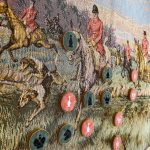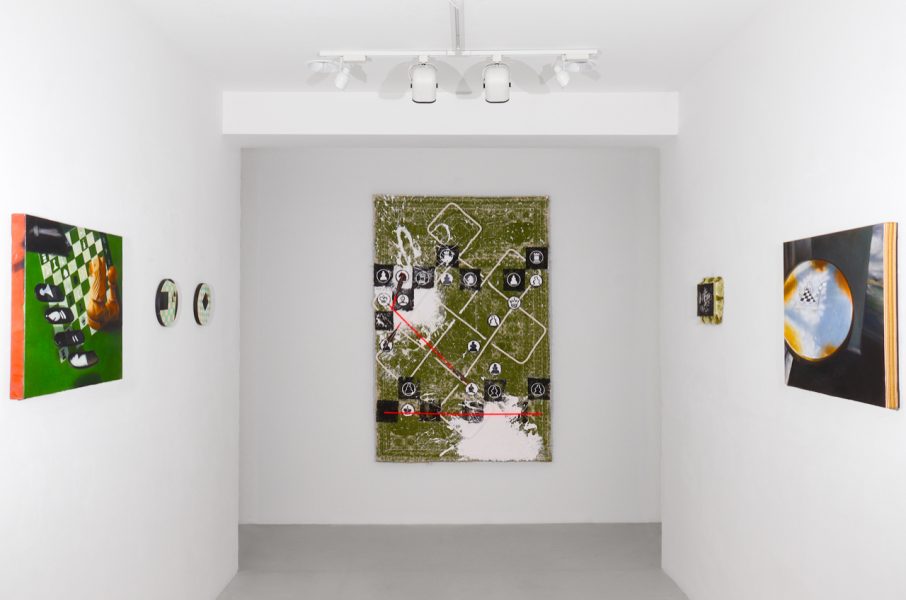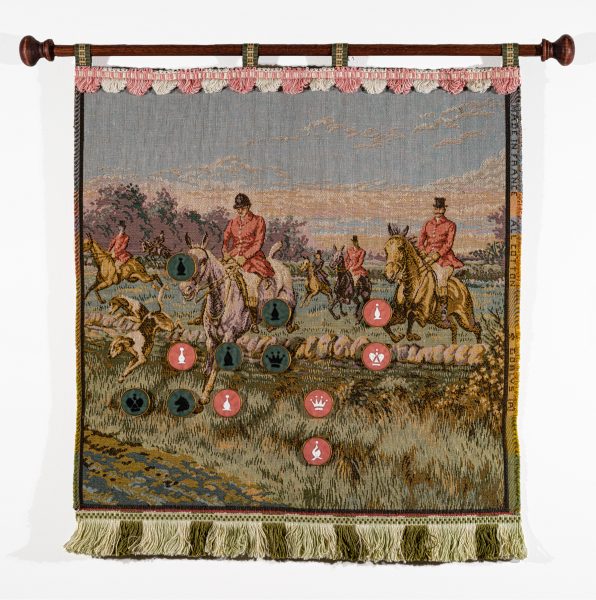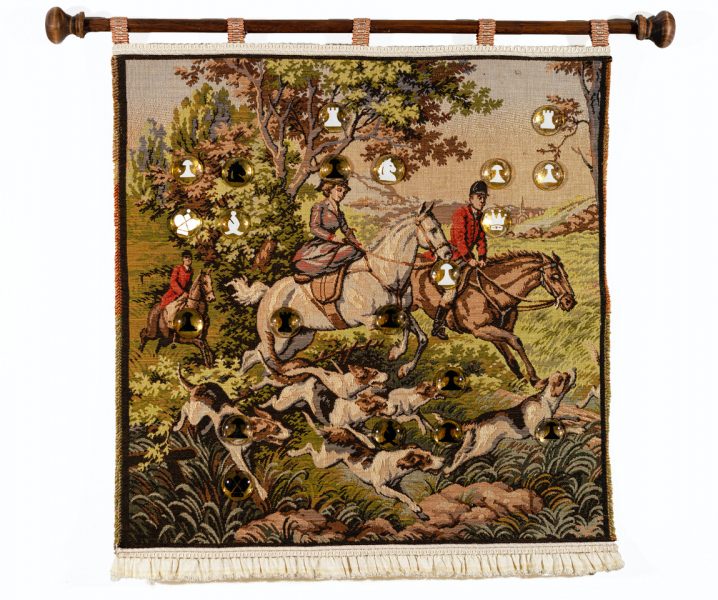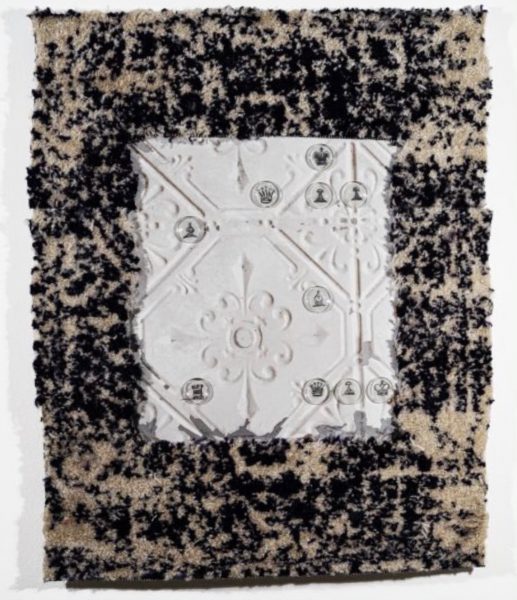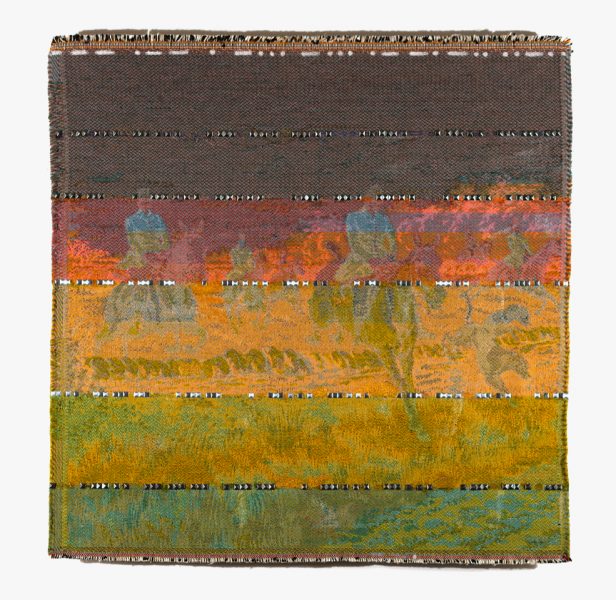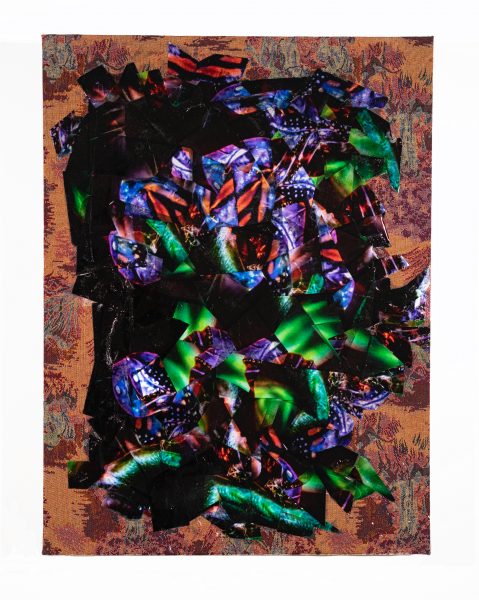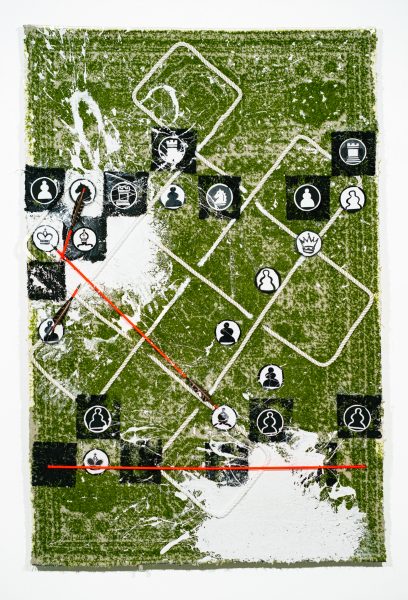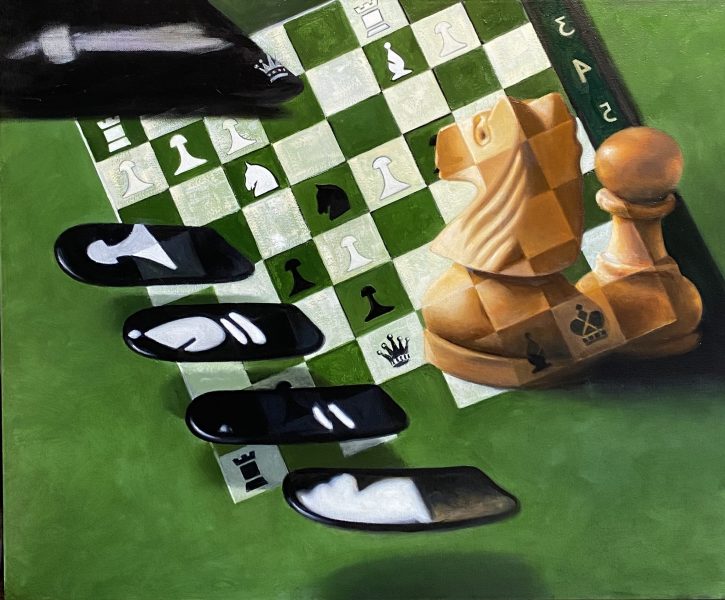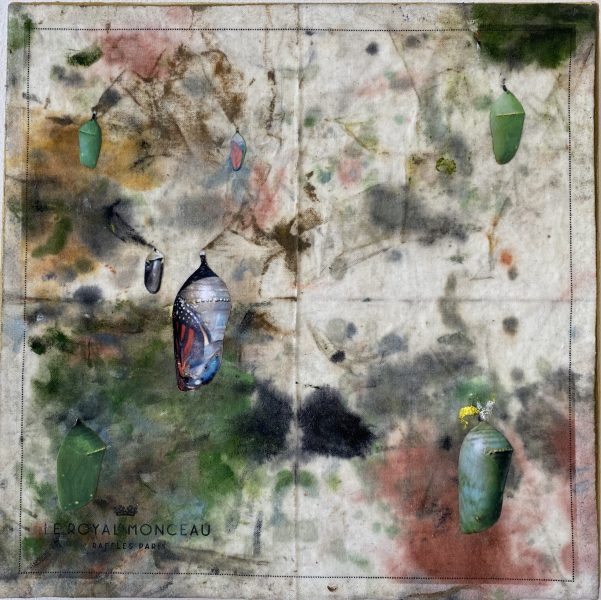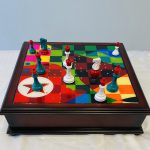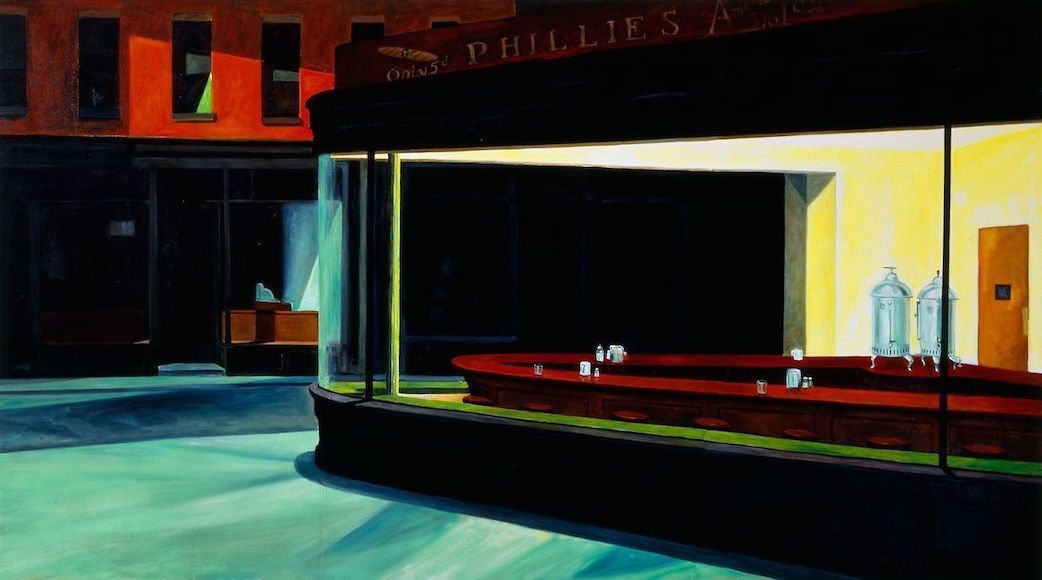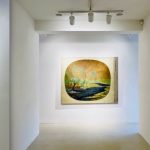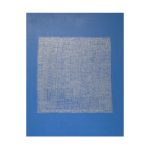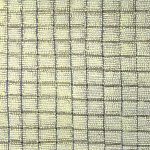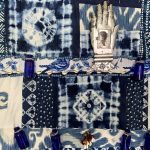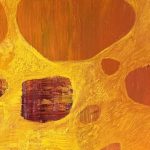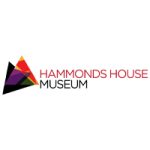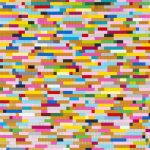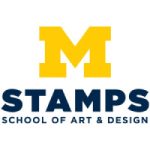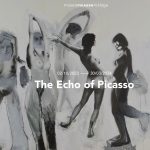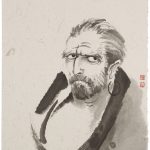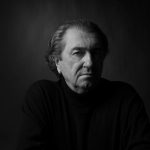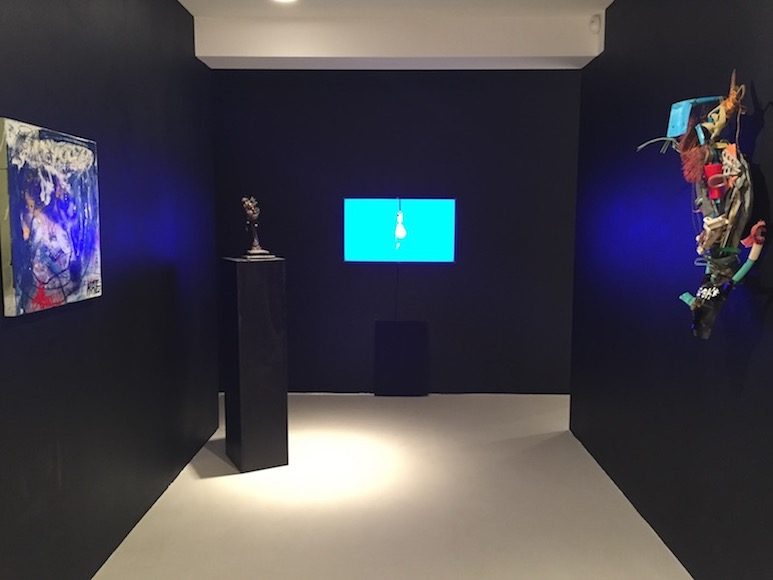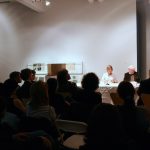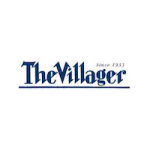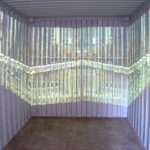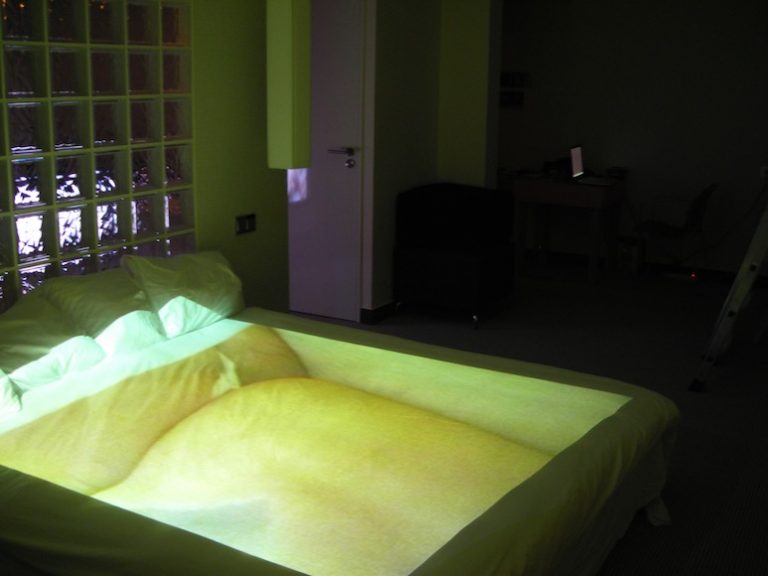LOVE DIFFERENCE
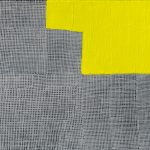
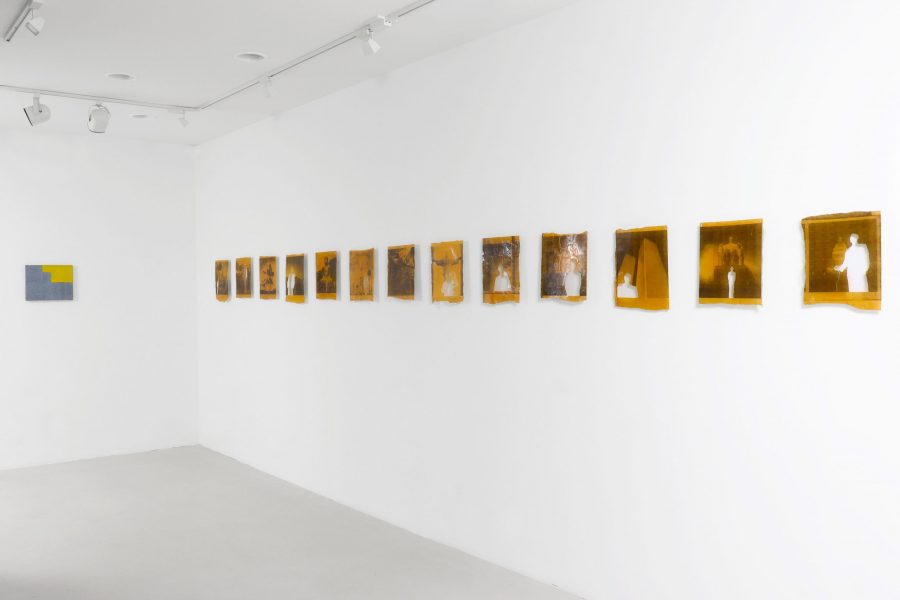
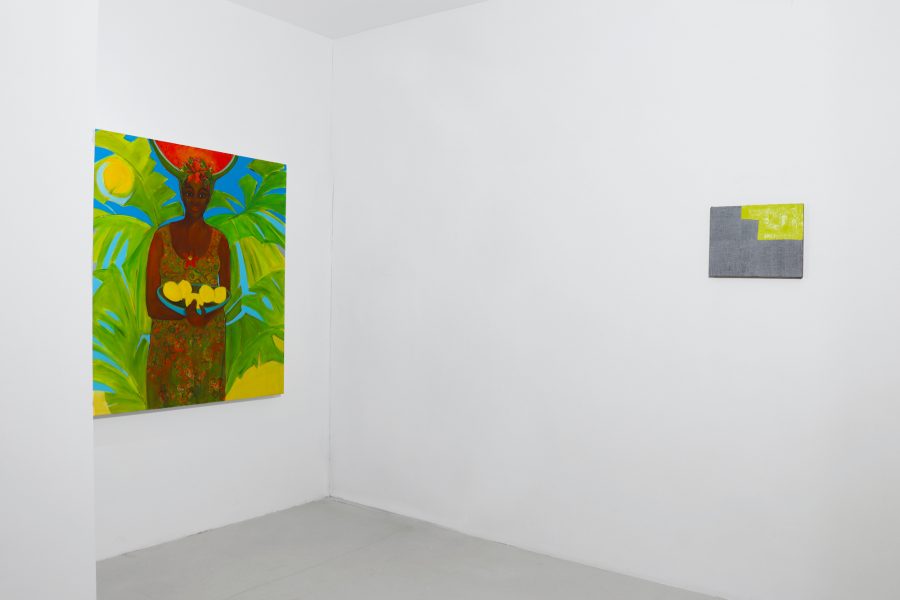

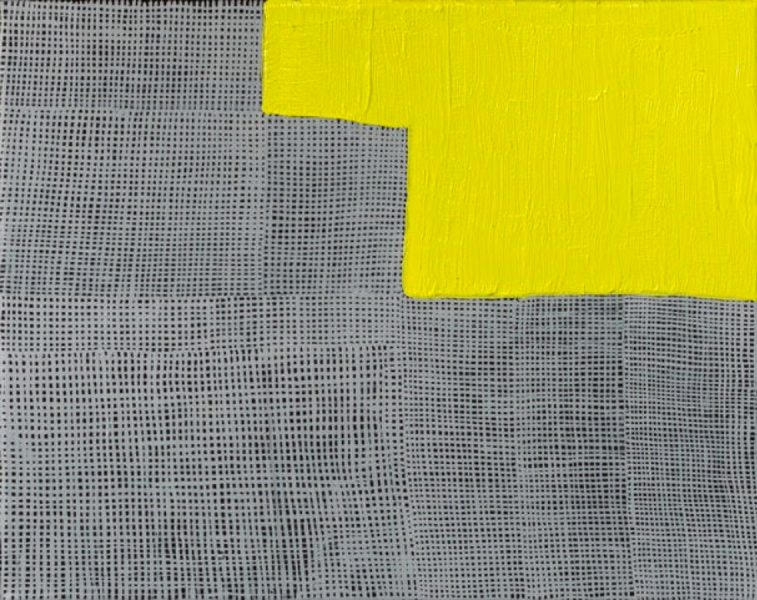

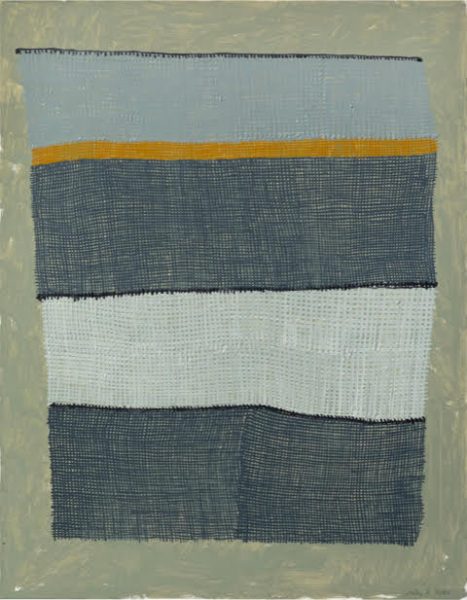

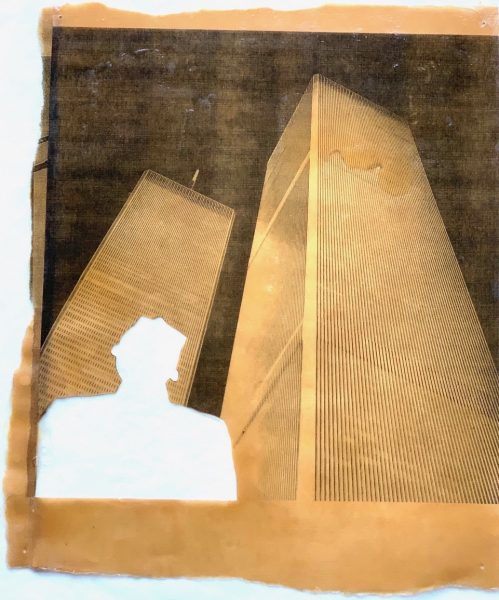
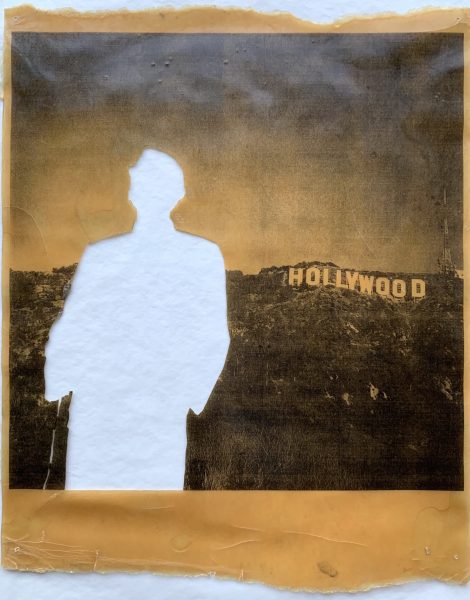
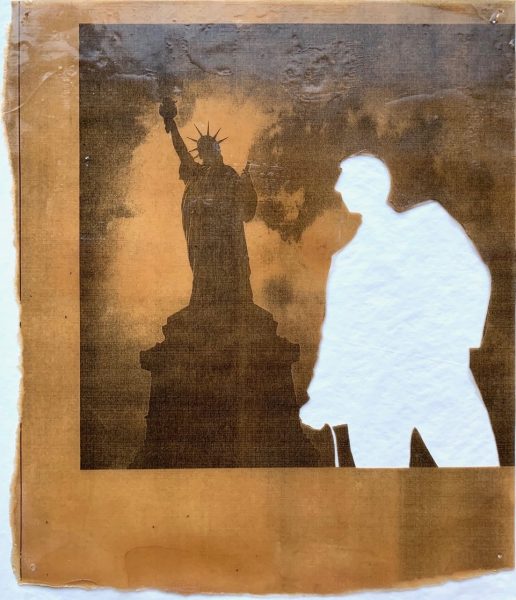
LOVE DIFFERENCE
May 15 – June 15, 2021
Eric Brown
“My recent paintings were made during a pandemic. Making them was a daily meditative practice. It was like keeping a journal. French philosopher Roland Barthes draws an analogy between text and textiles (“text” comes from the Latin texere, to weave). Through a repetition of mark-making, my paintings appear woven. They are not painted to look like textile. Their appearance is a byproduct of the painting process. The completed painting is a record of my experience making it. The eye follows “threads” of paint, their accumulation creating a larger whole. My new work is paradoxical: slow yet fast, precise yet open, deliberate yet intuitive. I am freer for having made them.”
Janet Taylor Pickett
“My Blackness is a declarative statement in my work. There are wonderful discarded objects brought home by my father and botanical prints my mother found from various second hand stores. Makers of things and tellers of stories surrounded me. In the late 1960’s and early 1970’ in the midst of sociopolitical activities, I began to formulate an aesthetic language, a visual synergy. The symbolism of the African American quilt, the pejorative images of the watermelon became part of my cryptology.”
Zhang Hongtu
…In Memory of Tseng Kwong Chi (1991) is a photo series that looked to the work of one of Zhang’s contemporaries, the Hong Kong-born performance artist Tseng Kwong Chi, who died of AIDS in 1990. Appropriating Tseng’s photographs, Zhang used the work of his friend to further extrapolate upon the mechanisms by which iconography constructs identity and how artistic intervention can disrupt the language of power. Created for the 1991 exhibition Dismantling Invisibility; Asia and Pacific Island Artists Respond to the AIDS Crisis, Zhang’s work selected fifteen photographs from Tseng’s acclaimed self-portrait series East Meets West (also known as the Expeditionary Self-Portraits, 1979-89) and reconfigured them into photo collages using his familiar epoxy technique. In these photos, Tseng performed the role of “ambiguous ambassador” and posited himself the stereotypical tourist sites (the Eiffel Tower, the Grand Canyon, the Hollywood sign) while dressed in a Mao suit. The series was a subversive yet ludic exploration of cultural identity, perception, and the status of the individual amid the monumental. In Zhang’s reworking of these photos, he cut out the figure of his close friend and colleague, leaving a ghostly silhouette in his absence. The removal of Tseng’s body next to the famous profiles of monuments and natural wonders created a displacement that was not only a deeply sentimental tribute to a dear friend, but, in the words of Zhang, “dismantled” the imagery further, disrupting historical continuity…
“Art and China After 1989, Theater of the World”
Guggenheim 2017
Page 237
https://www.guggenheim.org/exhibition/art-and-china-after-1989-theater-of-the-world
Related:

Janet Taylor Pickett is included in Century: 100 Years of Black Art at MAM
Categories: exhibitions
MORE THAN ONE WAY HOME
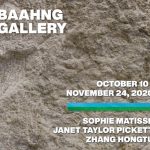
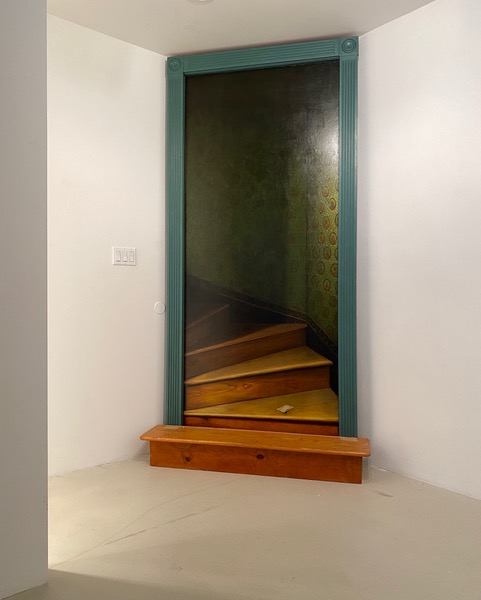
The Staircase Group, 2001
Oil on canvas with wooden step
108H x x 54Wx 13D in. (274.32H x 124.46W x 33.02D cm)

Homeward 1, 2020
Oil on wood
8 inch diameter (20.32 cm diameter)
&
Sophie Matisse
Origin of the World, 2003
Oil on canvas with velvet casing
18.5 x 22.5 in. (46.99 x 57.15 cm)

Nude Descending a Staircase, 2012
Oil on canvas
48 x 24 in. (121.92 x 60.96 cm)
&
Janet Taylor Pickett
She Has Agency, 2020
Acrylic and collage on canvas
40 x 40 in. (101.6 x 101.6 cm)
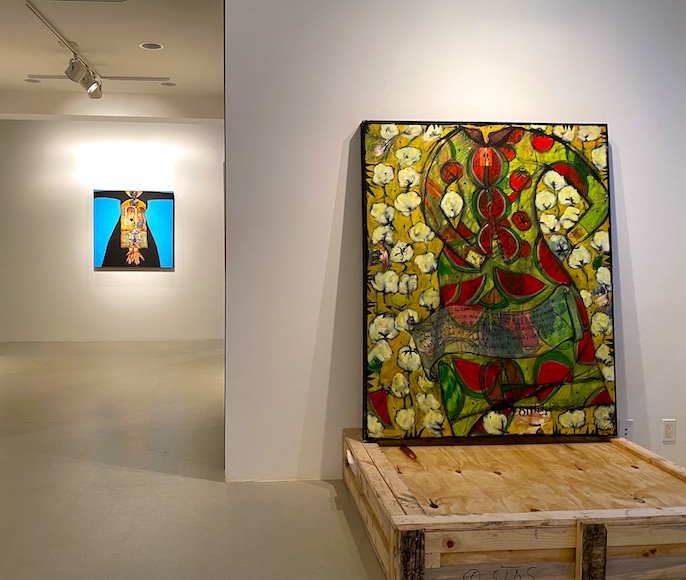
Ritual, 2003
Acrylic and collage on canvas
36 x 36 in. (91.44 x 91.44 cm)
&
Janet Taylor Pickett
Mellon Dress, 2001
Acrylic and collage on canvas
60 x 40 in. (152.4 x 101.6 cm)
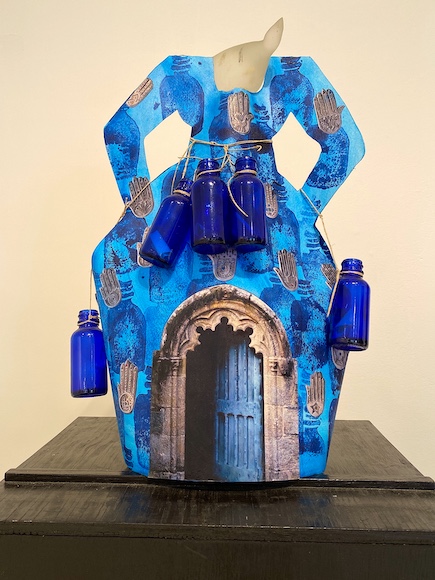
Charms & Inspirations, 2015
Sculpture with indigo blue glass bottles with messages inside, acrylic, collage,
and twine on shaped Arches paper over glass bottle
15 H x 10.5 W x 5 D in. (38.1H x 26.67 W x 12.7D cm)

Still image #29 from video version of Van Gogh/Bodhidharma,
a set of 39 Ink Paintings on paper, 2007-2014
approx. 35 x 25 in (88.9 x 63.5 cm) each
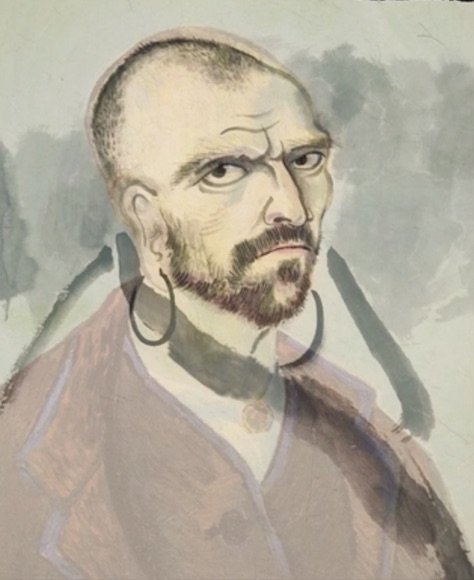
Still image #31 from video version of Van Gogh/Bodhidharma,
a set of 39 Ink Paintings on paper, 2007-2014
approx. 35 x 25 in (88.9 x 63.5 cm) each
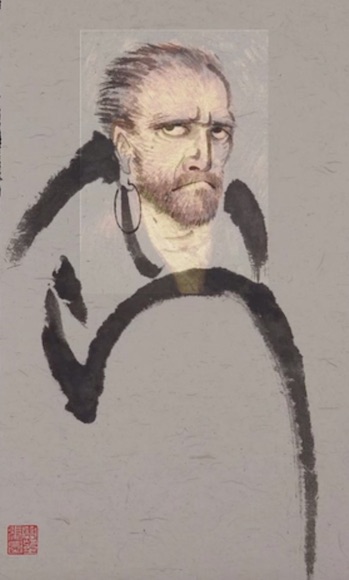
Still image #26 from video version of Van Gogh/Bodhidharma
a set of 39 Ink Paintings on paper, 2007-2014
approx. 35 x 25 in (88.9 x 63.5 cm) each
MORE THAN ONE WAY HOME
October 10 - November 24, 2020
Baahng Gallery celebrates its 2020 reopening with More Than One Way Home, an exhibition featuring the gallery’s represented artists: Sophie Matisse, Janet Taylor Pickett, and Zhang Hongtu. The exhibition offers a glimpse into the struggles of the artists and their coming to terms with their individual challenges. Sophie, the great-granddaughter of Henri Matisse and step-granddaughter of Marcel Duchamp, is an American oil painter working in New York City; Janet is an African American multi-media artist working on the West Coast; Hongtu is a Muslim Chinese artist who has been working in New York since 1982. The exhibition acknowledges and affirms that home, for these artists, is not situated in nostalgia. Rather, through a cyclical process of revisitation, they find home in both the present and future potential. More Than One Way Home follows a journey through each artist’s rite of passage in life and is a compelling visualization of distinct, individual expressive forms. Baahng Gallery is open Monday thru Friday, noon to 3pm, and by appointment.
Selected works from Sophie Matisse’s ‘Be Back in Five Minutes’ series are strategically installed in the gallery. Returning to renowned paintings by Gustave Courbet, Marcel Duchamp, Man Ray, Charles Wilson Peale through her unique lens, she appropriates and embellishes upon, or subtracts from, recognizable works from art history. The interplay between absence and presence in these haunting paintings is evocative. Featured as well is her most recent painting, ‘Homeward 1’. In this contemplative autobiographical tondo completed during the pandemic quarantine, the artist positions an errant chess piece peering out over a window ledge into the hazy verdant void, invoking solitude and the uncertain but hopeful future ahead.
‘Mappings of Memory’, a survey showcasing Janet Taylor Picket’s works, introduces selected paintings, collages, sculptures, and quilts from the 1990s through 2020. Her experiential work chronicles her journey as an African American woman, daughter, mother, and artist. Images drawn from art history, Africa, America and Europe, past and present, coexist in her often-ornate collages and paintings, defying linear timeframes and logical geographic or cultural relationships. The inclusion of the shipping crates in which the works were transported to the gallery adds a poignant historical dimension to the installation, referencing both her personal odyssey and that of her ancestors. The suggestive titles of the works on view reflect her creative vision: ‘Spirit Catchers', ‘Hot House', 'Melon Dress’, 'Exotica Botanica’, ‘Thoughtful Resilience’, and ‘She Has An Agency,’ the latter produced in 2020. These works constitute the artist’s confessional narrative circling back with newly found wisdom in life as well as in art. More Than One Way Home inaugurates Pickett’s representation with Baahng Gallery and presents her first New York exhibition.
Zhang Hongtu’s video, ‘Van Gogh/Bodhidharma’, is the centerpiece of his installation. This mesmerizing video production builds on his seven-year project (2007 – 2014), a set of 39 ink paintings that rework Van Gogh’s 39 extant self-portrait oil paintings in the style of classical Zen portraits of Bodhidharma. Revealed in both this video and the original endeavor upon which it was based are parallels in the lives and aesthetics of Zhang and Van Gogh. The artist compels viewers in both iterations of this project to reconsider Van Gogh’s fascination with Asian aesthetics, registering a more philosophical connection and inner resonance between the European post-impressionist artist and the East. Reflecting upon this project, Zhang expresses his approach as one that ‘dares to mate a horse with an ox’. Framing the video are wall texts quoting provocative passages from Van Gogh’s letters to his brother Theo and to Paul Gauguin. More Than One Way Home marks the launch of Zhang’s visionary ‘Van Gogh/Bodhidharma Project’—a quixotic effort to unite his ink paintings with the original painted portraits—and announces his official gallery representation with Baahng Gallery.
Related:

Sophie Matisse was interviewed by BBC TWO on “Becoming Matisse”

Janet Taylor Pickett is included in Century: 100 Years of Black Art at MAM
Categories: exhibitions
MICHAEL MCCLARD
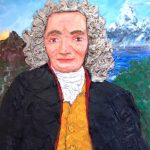
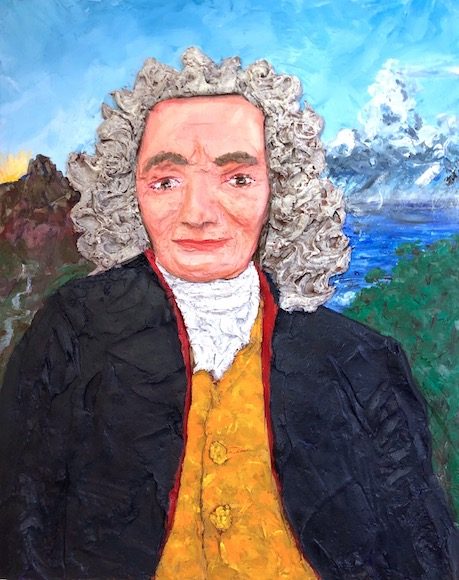
Candide, 2019
Styrofoam, fiberglass mesh reinforced BTS supporting acrylic enhanced plaster and acrylic paint, 24 karat gold leafs
30H x 24W x 3D inches
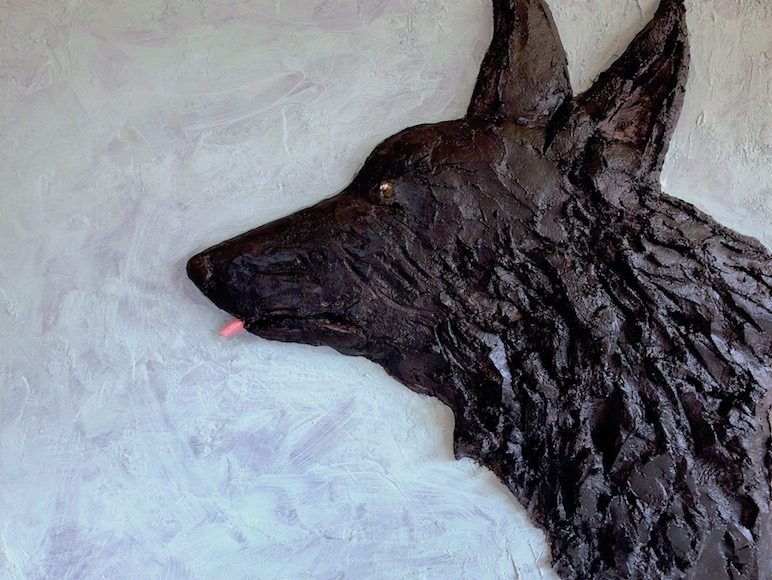
Maybe, 2019
Styrofoam, fiberglass mesh reinforced BTS supporting acrylic enhanced plaster and acrylic paint, 24 karat gold leafs
18H x 24W x 3D inches

Stephen Hawking, 2019
Styrofoam, fiberglass mesh reinforced BTS supporting acrylic enhanced plaster and acrylic paint, 24 karat gold leafs
20H x 24W x 3.5D inches
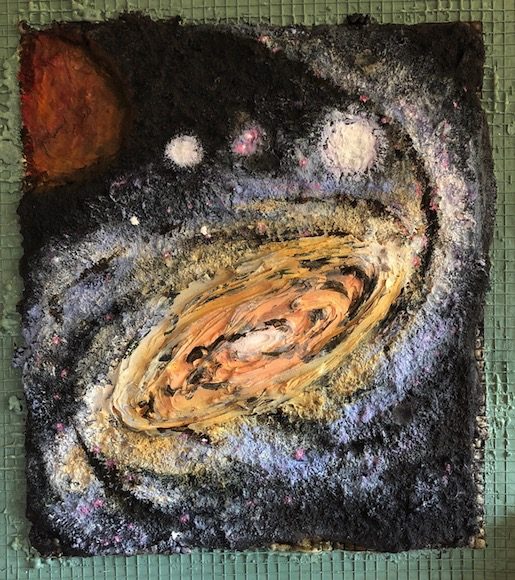
Someplace in Space
2018
Mixed media
27 x 24 inches
Michael McClard arrived in New York in 1973 with a BFA from the San Francisco Art Institute, where he also won a Peabody Award in Sculpture. He soon made his mark on the art scene as a member of a highly original group of young artists who helped to revive an interest in painting and visual performance. He was a founding member of the noted artists’support group Colab and its first president.
Sidestepping the confines of abstract conceptual art, McClard’s work seethes with figurative content; yet it has nevertheless retained a conceptual element and mines a strong vein of humor.
During the 70s he staged provocative performances such as “Foes v. Foes” at the Kitchen and surreal, carnivalesque installations at venues such as the Clocktower (“There’s Meat on these Bones”); PS 1, Institute for Art and Urban Resources, De Appel, Amersterdam and N.A.M.E Gallery, Chicago. For these presentations, he constructed all sets and props and performed, often as sole actor. His one-act play, “Mumbo Jumbo,” was published in Avalanche 12, Winter 1975.
In October 1981, his first large-scale one-man show of paintings and frescoes took place at Mary Boone, occupying both galleries on either side of West Broadway. Drawing on sources from mythology, history and everyday life, he created a pantheon of imaginary characters, notable for their tactile raw energy, range of facial expressiveness and astute power of observation. Also featured were inventive depictions of historical scenes, acclaimed by critics such as Grace Glueck of the New York Times for their verve and by Hal Foster of Art in America for their metaphysical insights. Many of these works were acquired by New York and Los Angeles public and private collectors. During this period McClard was also awarded two fellowships by the National Endowment for the Arts, in Visual Arts and Mixed Media.
In the 90s McClard took a temporary hiatus from painting to explore new media. He embraced the digital revolution and applied his draughtsmanship skills to the creation of original software with his brother Peter McClard through their enterprise, Hologramophone Research. The computer installation “DNA Characters” extended his interest in human physiognomy by generating an unlimited sequence of drawings of faces and was exhibited in “A visage découvert,” Fondation Cartier pour l’Art Contemporain, Jouy-en Josas, France.
Among the many group shows in which his paintings and objets d’art have been featured are “Figures of Mystery”, Queens Museum, NY; “The Pressure to Paint”, Marlborough Gallery, NY; “TV’s IN”, Max Fish, New York, and The Barry Lowen Collection, Museum of Contemporary Art, Los Angeles, CA.
More recently, McClard’s experimental short films Alien Portrait (1978) and Contortions (1978) were given their world premiere at “No Wave Cinema, 1978-87” at the Whitney Museum of American Art.
Education:
BFA, San Francisco Art Institute in 1971, moved to New York 1973
Two National Endowment of the Arts Fellowships, one in Multi Media, the other, as a Visual Artist.
REVIEW QUOTES FOR MICHAEL McCLARD
“. . .An oddball but wonderful choice, for example, is Michael McClard’s ‘’Mise en Scene (circa 1500),’’ a painting based on the life of Michelangelo. Built out from the picture plane with thick plaster slabs and painted frescolike in rich colors that bring an old-master palette into the 20th century, it depicts Michelangelo in his cathedral workroom, wearing a funnel hat with a candle in it, leaning intently over a scabrous cadaver. At once affecting and funny in its comment on the profession of artist, it’s brought off with great verve.”
Grace Glueck, “Figures of Mystery,” The New York Times, Jan 7 1983 Participating artists included Susan Rothenberg and Eric Fischl.
“. . . All in all the show was a bizarre delight. . .Post-minimalist artists often used materials that were somehow tabooed, but McClard’s art is funnier than theirs. It is also more ambitious in content: the show ranged from shit to Saturn, from grotesques to Christs. Here was an art with a cosmology—the universe as delusion of grandeur. . .But the delusion seemed to know itself as such . . .
“. . .The clown, the circus, are also part of the iconography of painting . . . Artists like Schnabel and Clemente pretend to paint the great carnival of time, only to fall back on an old clown act. McClard, at least, shows signs that he knows his act for what it is . . .”
Hal Foster, “Michael McClard at Mary Boone,” Art in America, December 1981
Solo Exhibitions:
1988 “Things”, Willoughby Sharp Gallery, N.Y. NY
1987 Suzan Cooper Gallery, N.Y. NY 86 Simon Cerigo Gallery, N.Y. NY
1985 Curated by Atanasio Di Felice, Harm Bouckaert Gallery, N.Y. NY
1982 American Graffiti Gallery, Amsterdam NE 81 Mary Boone Gallery, N.Y. NY
1977 Konrad Fischer Tunnel Space, Dusseldorf, W. Germany
“Trial by T.V.”, Hallwalls, Buffalo, N.Y. NY 1975
1975 “There’s Meat on These Bones”, The Clocktower, Institute for Art and Urban Resources, N.Y. NY
Group Exhibitions:
2007 The Downtown Show: The New York Art Scene, 1974–1984 (Broken Stories), curated by Carlo
McCormick, New York, NY
1997 “Last Party,” Serge Sorokko Gallery, New York, NY
1996 “No Wave Cinema 1978–81,” Whitney Museum of American Art, New York, NY
1993 “A visage découvert” Fondation Cartier pour l’Art Contemporain, Jouy-en Josas, France
1990 “Aquarian Artists,” Fine Arts Center, University of Rhode Island, Kingston, RI.
“TV’s IN” Max Fish, N.Y. NY
1989 “Prisoners of Art,” Police Building, N.Y. NY
1988 “Micro sculpture” Fine Arts Center, University of Rhode Island, Kingston, R.I.
“Rebop”, curated by Glen O’brien, Paula Allan Gallery, N.Y. NY
1986 “The Bary Lowen Collection”, MOCA’s Temporary Contemporary, Los Angeles, CA
Simon Cerigo Gallery, N.Y. NY Benefit for the Poetry Project at St. Marks Church, N.Y. NY
1984 “Hundreds of Drawings”, Artists Space Benefit, N.Y. NY “Bomb Magazine Benefit”, Blum-Helman Warehouse, N.Y. NY Art Palace, N.Y. NY
“Sex Show”, Cable Gallery, N.Y. NY
1983 “Prints and Drawings for Collectors”, New Gallery of Contemporary Art, Cleveland, OH
1983 “Terminal New York,” AAA Art, N.Y. NY
“Intoxication,” Monique Knowlton Gallery, N.Y. NY “Sweet Art”, Ronald Feldman Gallery, N.Y. NY
“The Pressure to Paint” Marlborough Gallery, N.Y. NY “Figures of Mystery”, Queens Museum, Queens, N.Y. “Beast: Animal Imagery in Recent Painting”, PS1, Institute for Art and Urban Resources, L I C, NY “New Figuration in America”, Milwaukee Art Museum, Milwaukee, Wis.
1982 “Critic’s Choice”, PS 1, Institute for Art and Urban Resources, Long Island City, NY
1981 “New York: New Wave,” PS 1, Institute for Art an Urban Resources, Long Island City, NY
“Gallery Artists” Mary Boone Gallery, N.Y. NY
1979 “Bat Man Show”, 591 Broadway, N.Y. NY “The Doctors and Dentists Show, 591 Broadway, N.Y. NY “Income and Wealth Show”, 5 Bleeker Street, N.Y. NY
1978 “Exhibit A”, 93 Grand Street, N.Y. NY 1977 “New Art Auction and Exhibition”, Artists Space, N.Y. NY
1976 “Ten in Situ”, Colgate College, Hamilton, N.Y.
1975 “Continuing Work in Various Media” 597 Broadway, N.Y. NY
1970 “Young Bay Area Sculptors”, Emanuel Walter Gallery, San Francisco, CA
Glueck, Grace, ”Art: One Man’s Biennial Assembles 102 Artists,“ The New York Times, 15 April 1983
Mouferage, Nicolas, ”Intoxication, 9 April 1983,“ arts Magazine, April 1983 Preston, ”Art Review: Mystery in Queens,“ Newsday, 7 January 1983
Glueck, Grace, ”Art: ’Figures of Mystery‘ Shows New Work By 10,“ The New York Times, 7 January 1983
Sussler, Betsy, ”Michael McClard Interview“ Bomb Magazine, No.4, January 1983
Glueck, Grace, ”Of Beasts and Humans: Some Contemporary Views,“ The New York Times, 14 November 1982
Wolf, Deborah, ”Mary Boone“ Avenue, October 1982
Price, Katherine, ”Arte USA,“ Nouvi Argomenti, August-September 1982
Silverthorne, Jeannie, ”The Pressure to Paint,“ Artforum, October 1982
Wolfert-Wihlborg, Lee, ”Manhattan’s Avant-Garde Art Dealers,“
Town and Country, September 1982 (photo of ”Los Alomos,” p. 250)
Foster, Hal, ”Between Modernism and the Media,“ Art in America, Summer 1982
Smith, Roberta, ”Group Flex,“ The Village Voice, 22 June 1982
De Ak, Edit and Cortez, Diego ”Baby Talk,“ Flash Art, May 1982
Haden-Guest, Anthony, ”The New Queen of the Art Scene,“ New York Magazine, 19 April 1982
Castle, Ted, ”Michael McClard’s Faces,“ Artforum, January 1982
Yoskowitz, Robert, ”Michael McClard,“ Arts Magazime, December 1981
Acker,Kathy, ”Motive: Interview with Michael McClard“ Bomb Magazine, No.1, January 1981
Rose, Frank, ”Exploring the Art-Rock Nexus, (Part III)“ Artexpress, November 1981 (photo of ”Someone“ and ”Somebody“)
Foster, Hal, ”Michael McClard at Mary Boone,“ Art in America, December 1981 (photo of ”The Devil Goes to the Circus“)
Larson, Kay, ”Fear of Style,“ New York Magazine, 9 November 1981 Smith, Roberta, ”Space Walk,“ The Village Voice, 21 October 1981 Goldberg, Rosalee, Studio International, January 1977 Perron, Wendy, The SOHO News, 15 May 1976
Frank, Peter, The SOHO News, 15 January 1976 Moore, Alan, Artforum, Summer 1975
REVIEW QUOTES FOR MICHAEL McCLARD
“. . .An oddball but wonderful choice, for example, is Michael McClard’s ‘’Mise en Scene (circa 1500),’’ a painting based on the life of Michelangelo. Built out from the picture plane with thick plaster slabs and painted frescolike in rich colors that bring an old-master palette into the 20th century, it depicts Michelangelo in his cathedral workroom, wearing a funnel hat with a candle in it, leaning intently over a scabrous cadaver. At once affecting and funny in its comment on the profession of artist, it’s brought off with great verve.”
Grace Glueck, “Figures of Mystery,” The New York Times, Jan 7 1983 Participating artists included Susan Rothenberg and Eric Fischl.
“. . . All in all the show was a bizarre delight. . .Post-minimalist artists often used materials that were somehow tabooed, but McClard’s art is funnier than theirs. It is also more ambitious in content: the show ranged from shit to Saturn, from grotesques to Christs. Here was an art with a cosmology—the universe as delusion of grandeur. . .But the delusion seemed to know itself as such . . .
“. . .The clown, the circus, are also part of the iconography of painting . . . Artists like Schnabel and Clemente pretend to paint the great carnival of time, only to fall back on an old clown act. McClard, at least, shows signs that he knows his act for what it is . . .”
Hal Foster, “Michael McClard at Mary Boone,” Art in America, December 1981
1979 ”Axel Radius,“Corpes de Garde, Gronigen; De Appel, Amsterdam, Holland
1977 ”Plan K,“N.A.M.E. Gallery,Chicago Illinois ”Comedy of Pain (The Telephone Rings),“ SUNY at Buffalo, Ny
1976 ”Clamor Clobber Comb,“ Artists Space, N.Y. NY ”Temperate Tantrum,“ 17 White Street, N.Y. NY ”Merely Hearsay,“17 White Street, N.Y. NY
1975 ”Foes v. Foes (A Christmas spectacle),“ The Kitchen, N.Y. NY ”There’s Meat on These Bones,“ The Clocktower, N.Y. NY
1972 ”Moth, Flame, Phoenix (Airplane with television),“ 3675 Clementina Street, San Francisco, CA
1983-7 School of Visual Arts, N.Y. NY, foundation drawing
1987 San Francisco Art Institute, SF, California, advanced painting
1986 Parsons School of Design, N.Y. NY, advertising design
Categories: exhibitions
Tags: Michael Mcclard
Gary Hill and Nam June Paik at Art Taipei 2008

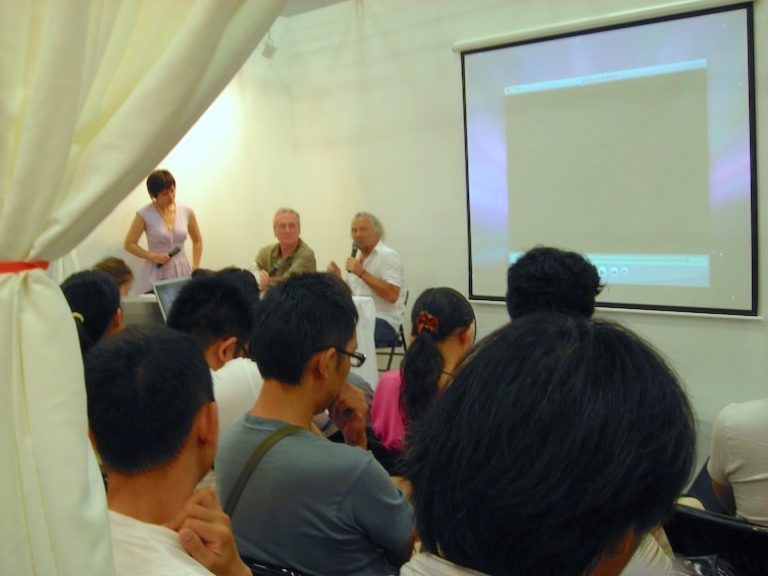
Giving lecture and discussion on “Language Beyond Its Own Limits"
August 30, 2008
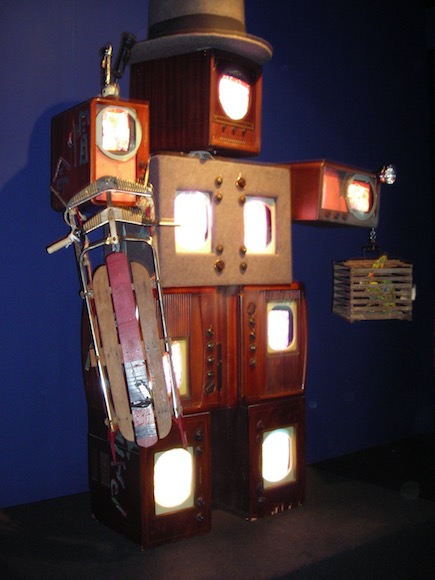
Beuys Voice
1990
265 x 188 x 95 cm
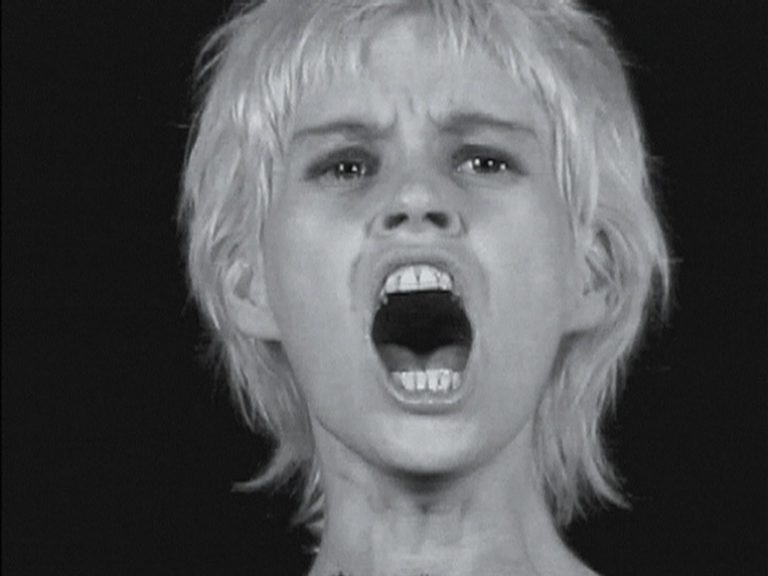
Remembering Paralinguay
2000, Single-channel video/sound installation
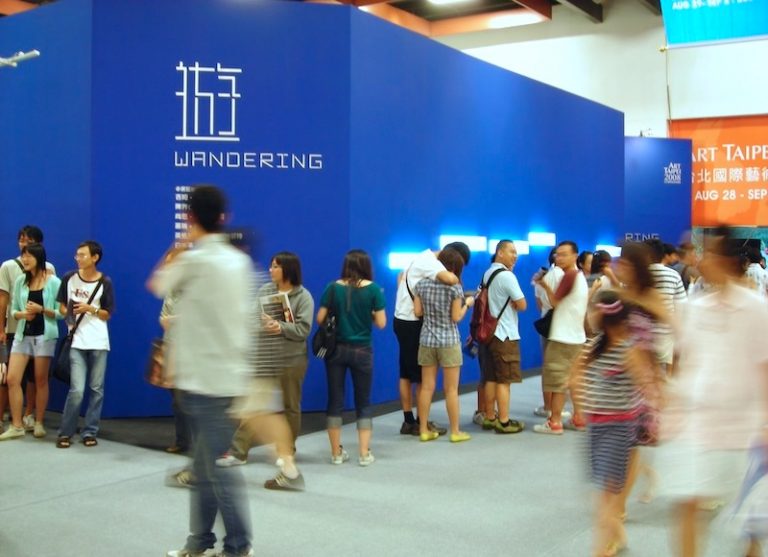
Art & Tech - Wandering
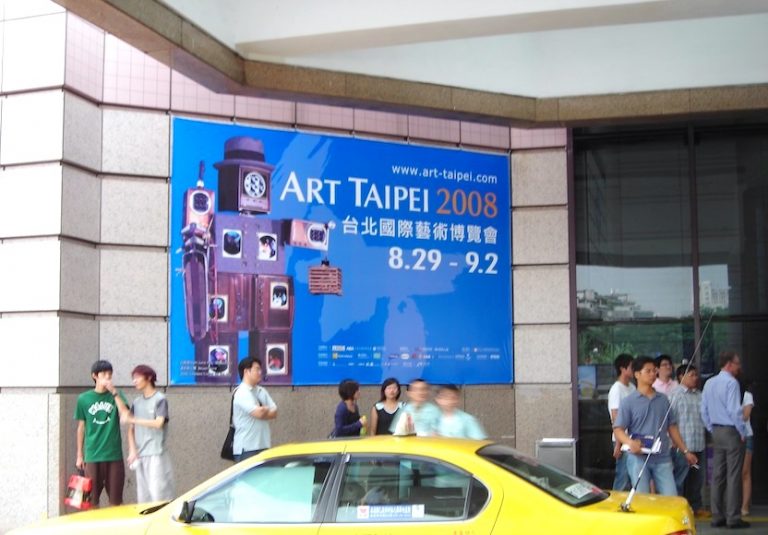
At the Art Taipei’s invitation for their 2008 Year Project, “Art & Tech – Wandering”, ZONE: Chelsea Center for the Arts presented Gary Hill’s “Remembering Paralinguay” and Nam June Paik’s “Beuys Voice” for the special exhibition during Art Taipei 2008.
George Quasha and Gary Hill gave lecture and Q&A on August 30, 2008 titled “Language Beyond Its Own Limits”
Nam June Paik
Beuys Voice
1990
265 x 188 x 95 cm
Gary Hill
Remembering Paralinguay
2000
Single-channel video/sound installation
Video projector and mount, four amplified speakers, DVD player and one DVD (black-and-white; sound)
Performer: Paulina Wallenberg-Olsson
Dimensions variable
Photo: Courtesy Donald Young Gallery, Chicago
Related:
Categories: exhibitions
Tags: Gary Hill Nam June Paik
Nam June Paik at ARTSingapore 2008


Blue Buddha
1992 – 1996
250 x 155 x 205 cm
At the invitation of ARTSingapore to organize their Special Exhibition Project for 2008 edition, ZONE: Chelsea Center for Arts organized Nam June Paik’s exhibition presenting Blue Buddha.
Nam June Paik
Blue Buddha
1992 – 1996
250 x 155 x 205 cm
Courtesy of the Kim Soo Keong Collection
ARTSingapore 2008 Special Exhibition, “Nam June Paik: An Intimate Retrospective from the Kim Soo Keong Collection”.
ARTSingapore 2008
October 9 – 13, 2008
Suntec Singapore, International Convention and Exhibition Center
Related:
Categories: exhibitions
Tags: Nam June Paik
BRIAN DAILEY: WORDS: A Global Conversation
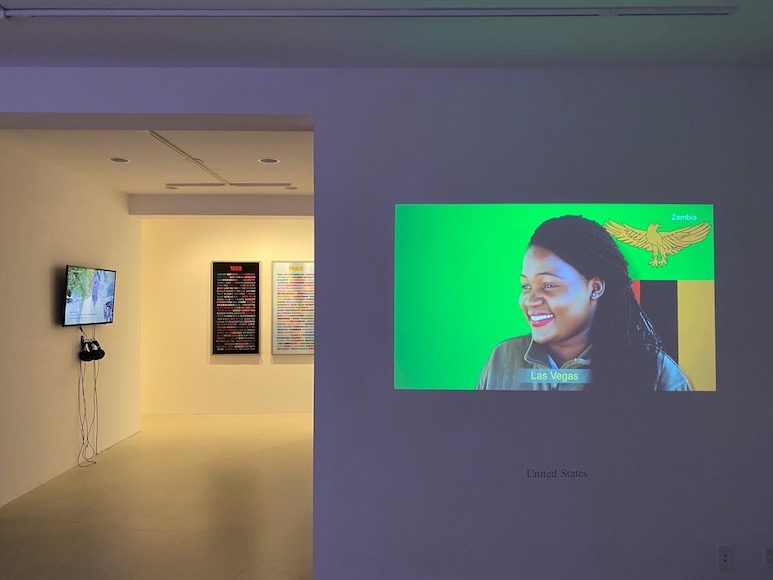
WORDS: A Global Conversation
Installation view
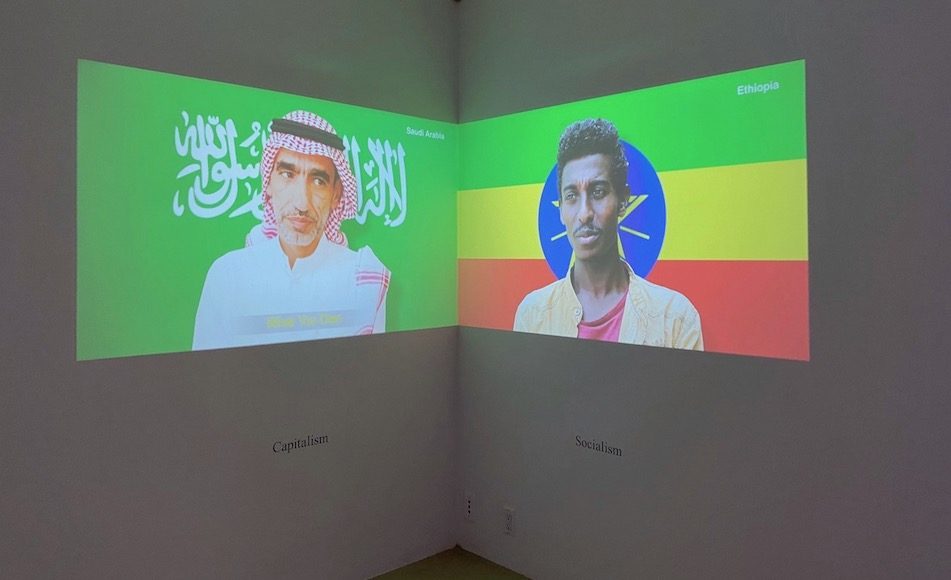
WORDS
2012-2019
A time based multi media installation single channel video with sound
Installation view

WORDS
2012-2019
A time based multi media installation single channel video with sound
Installation view
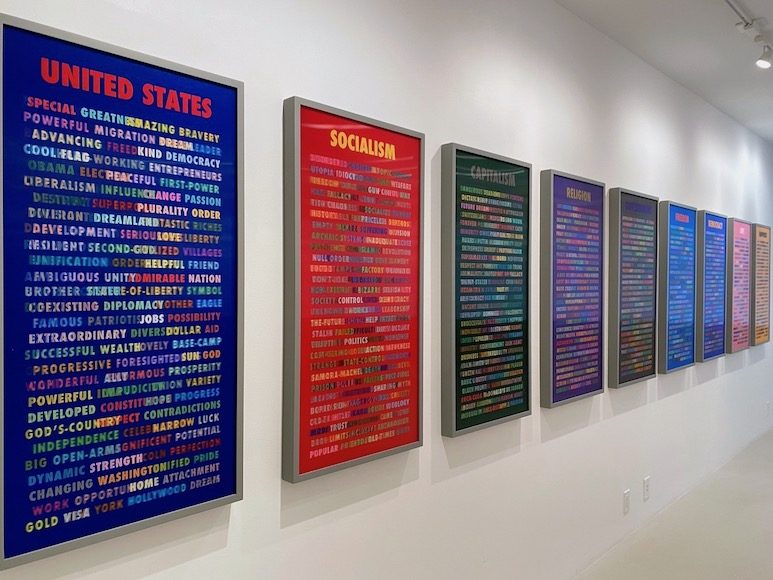
WORDS ON WORDS
2019
Lenticular Print
24 x 48 inches (61 x 122 cm)
Edition of 25 plus 5 AP’s
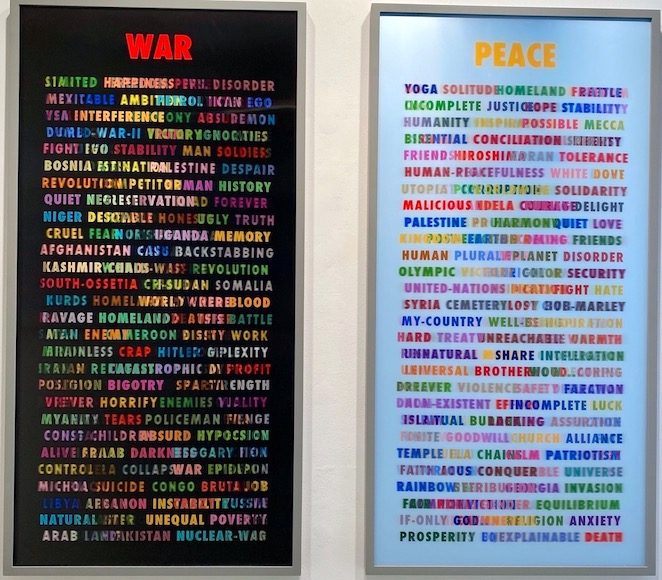
WORDS ON WORDS
2019
Lenticular Print
24 x 48 inches (61 x 122 cm)
Edition of 25 plus 5 AP’s
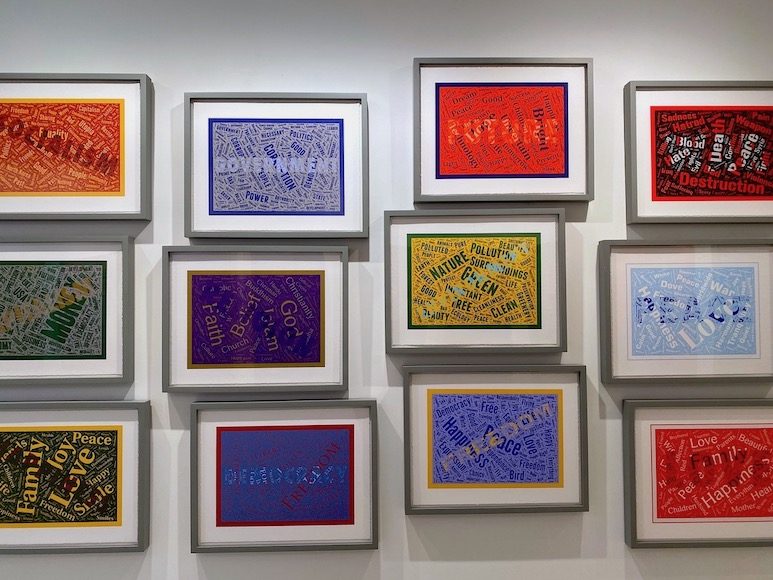
Tous les Mots
2018
Inkjet on museum etching paper 13 solos each unique
18 x 22 in. (46 x 58.5 cm)
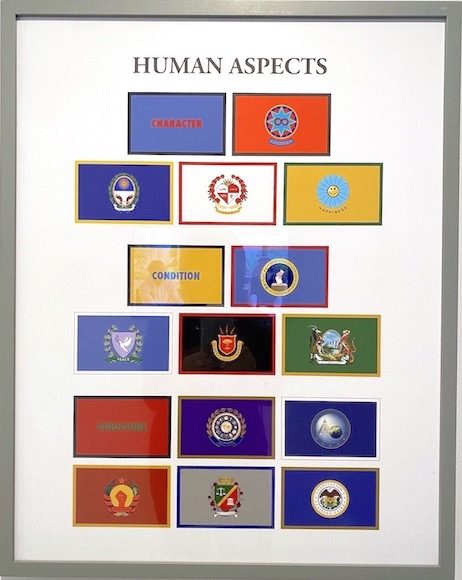
WORDS: Human Aspects
2018
A project taxonomy with artist illustrated pennons Inkjet on museum etching paper
29 x 23 in (73.66 x 58.42 cm)

WORDS ON WORDS
2019
Lenticular Print
24 x 48 inches (61 x 122 cm)
Edition of 25 plus 5 AP’s
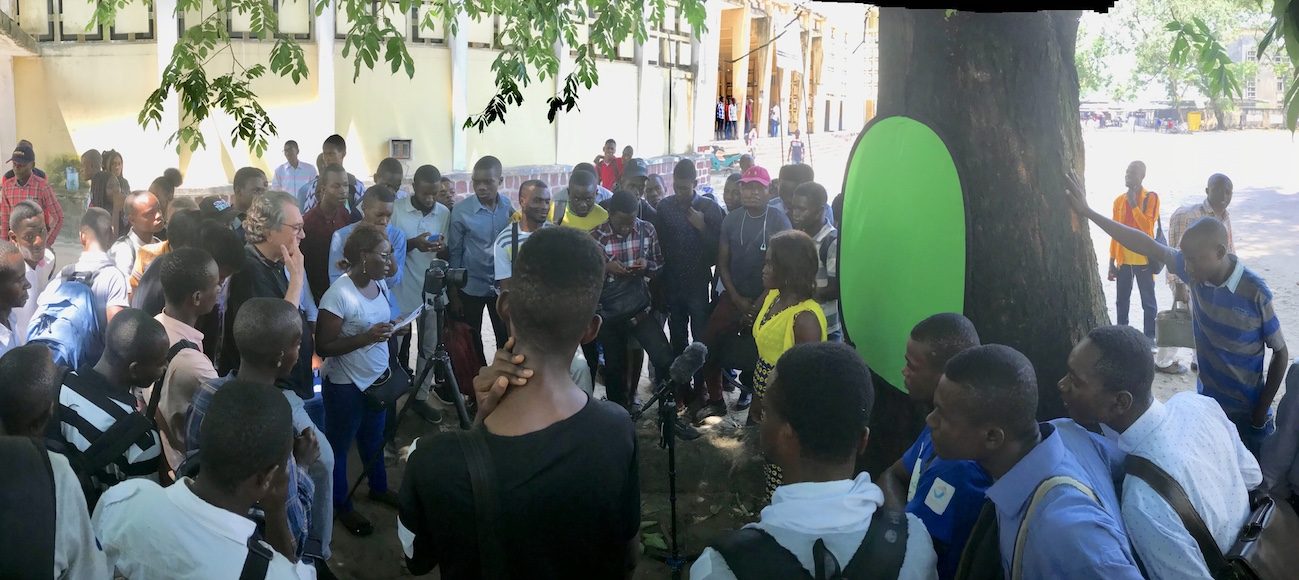
WORDS: Brazzaville, Congo, April 2019
2020
Inkjet prints
dimension varies

WORDS: Russia- War Victory
2012-2019
Dimension varies
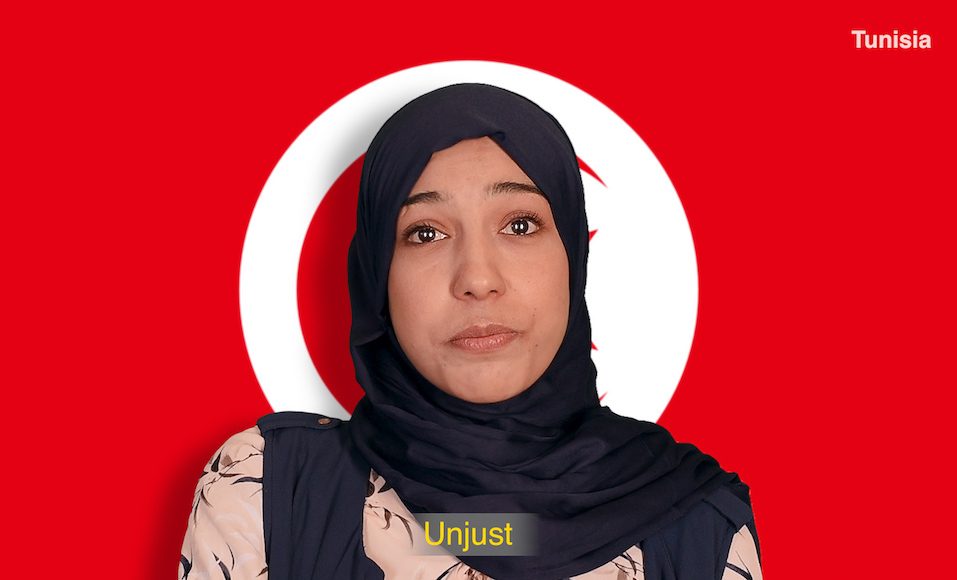
WORDS: Tunisia-Unjust
2012-2019
Dimension varies

WORDS: South Korea-North Korea
2012-2019
Dimension varies
Baahng Gallery is pleased to present WORDS: A Global Conversation, Brian Dailey’s creative summation of 7-year odyssey (2012-2019) that took him to 120 countries. Working in an international geopolitical landscape undergoing tumultuous and historic changes over the evolution of this project, Dailey visited public and private venues on all 7 continents. The exhibition is the inauguralof the project in its entirety and showcases WORDS MULTIMEDIA installation and WORDS ON WORDS, a 13 lenticular- print series. This exhibition is Dailey’s second solo show with the gallery and will run from February 11 thru March 17, 2020, accompanied with opening reception on Tuesday, February 11, 6-8pm, and Artist Talk on March 3, Tuesday, 5:30pm.
WORDS is the artist’s investigation into the impact of globalization and its effect on key human structures of language, society, culture, and environment.In each country, Dailey set up his camera with green-screen backdrop and invited random individuals. Participants were asked 13 words in their native languages: peace, war, love, environment, freedom, religion, democracy, government, happiness, socialism, capitalism, future, and United States. Each person responded—in a single word—with a first impression andselected a background flag reflecting his or her societal allegiance. WORDS MULTIMEDIA is a time-based artand engages the viewers in present day issues while invoking a communal sense among global citizens. In WORDS on WORDS, distinct single-word responses are layered in an immeasurable array of colors enhanced by the lenticular 3D effect. Interjecting his voice in a collaborative manner with the project’s participants, Dailey creates iconoclastic yet playful statements reminiscent of Dada and Surrealist word play.
Born 1951 in California, Brian Dailey earned MFA from Otis Art Institute in 1975 and Ph.D. from University of Southern California in 1987 and participated in the pioneering creative experimentation defining the prolific artistic milieu in California in this era. His early career launched him on a path that—before his full circle back to his arts in 2008—took him through a twenty-year interlude working on arms control and international security. These unusual experiences were a fertile source of inspiration in his idiosyncratic art practice. With dual citizenship of USA and New Zealand, He lives and works in the Washington D.C. and in Woodstock, Virginia. His selected solo exhibitions include at Katzen Arts Center, American University Museum in Washington D.C., in 2018 and his mid-career retrospective at Bulgaria’s National Art Gallery in Sofia in 2014. The evocative videoJIKAI was screened on multiple synchronized monitors in New York City in February, 2014, as the featured video in the Times Square Midnight Moment series; a project of ART PRODUCTION FUND. Brian Dailey is represented by Baahng Gallery.
Brian Dailey
WORDS: A Global Conversation
A solo exhibition by Brian Dailey
February 11 – March 17, 2020
Opening reception
6-8PM, Tuesday February 11, 2020
Artist Talk:
5:30PM, Tuesday March 3, 2020

WORDS on WORDS, 2019
Set of 13, Solos, Lenticular Prints 20 x 40 in, 24 x 48 in
50.8 x 101.6 cm, 70 x 122 cm edition of 25 plus 5AP’s each unique
WORDS on WORDS, a print series of the project, comprises 13 lenticular works. Distinct single-word responses derived from the answers of the more than 3000 participants in the project are layered throughout the panels in an immeasurable array of colors enhanced by the 3D effect. Interjecting his voice in a collaborative manner with the project’s participants from 134 countries, the artist combined these individual answers into two- or three-word phrases to create iconoclastic yet playful statements reminiscent of Dada and Surrealist word play.
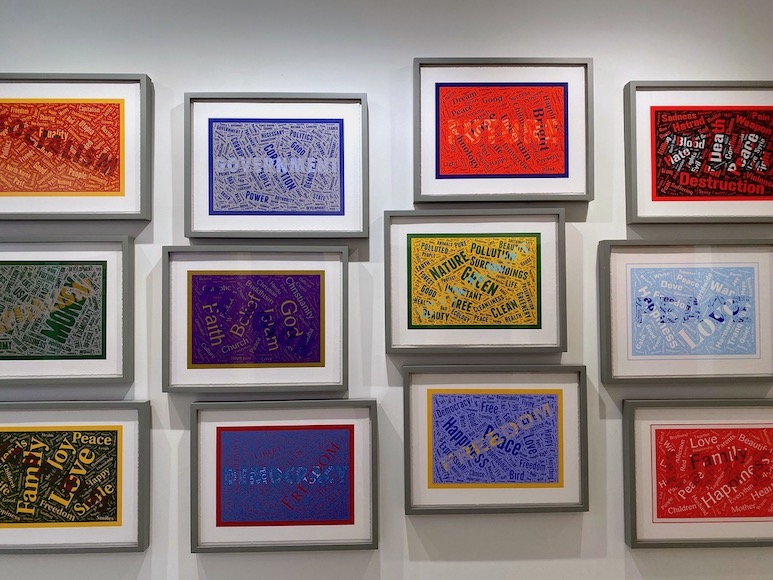
Tous les Mots, 2018
Inkjet on museum etching paper 13 solos each unique
18 x 22 in
46 x 58.5 cm
edition of 25 plus 5AP’s
Tous les Mots, is a play on the French expression tous les monde, which in its most literal sense translates as all the people in the world. By interjecting the French word for words—mots—it creates a double entendre highlighting both the global and individual voice of the project. The series encapsulates the very essence of this series in that every word uttered by the nearly 3,000 participants is represented in one of the prints corresponding to each of the thirteen words. This print series gives voice to each and every individual who engaged in the WORDS endeavor, the various responses were calibrated and scaled to reflect the frequency in which they were articulated – forming dynamic word clouds.
Related:
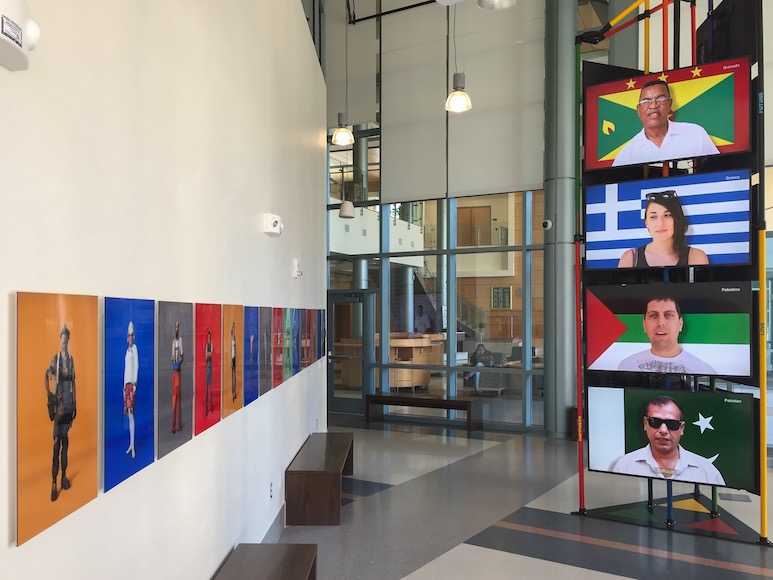
Brian Dailey at The Rachel M. Schlesinger Arts Center
Categories: exhibitions
Tags: Brian Dailey
BRIAN DAILEY: Polytropos
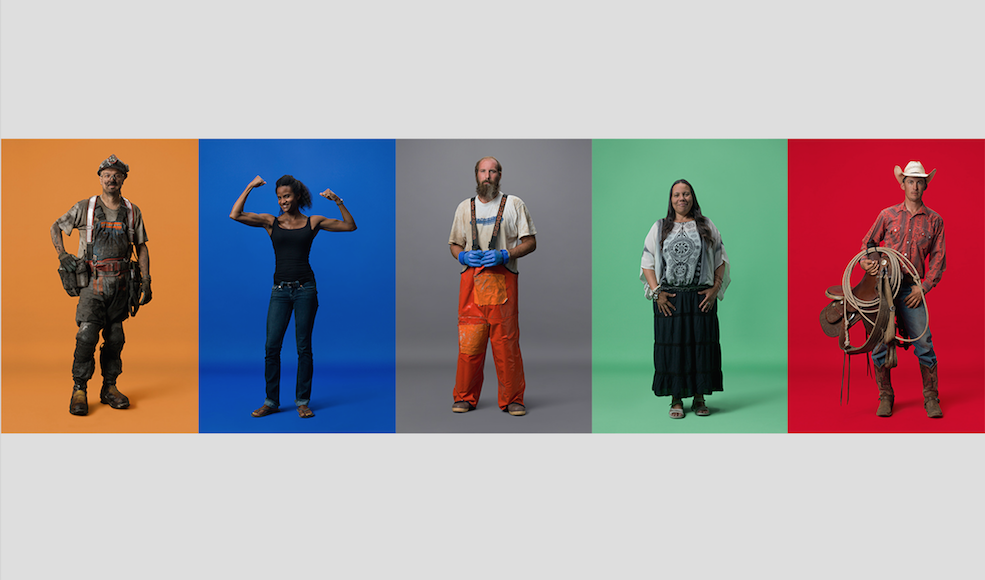
America in Color
2013
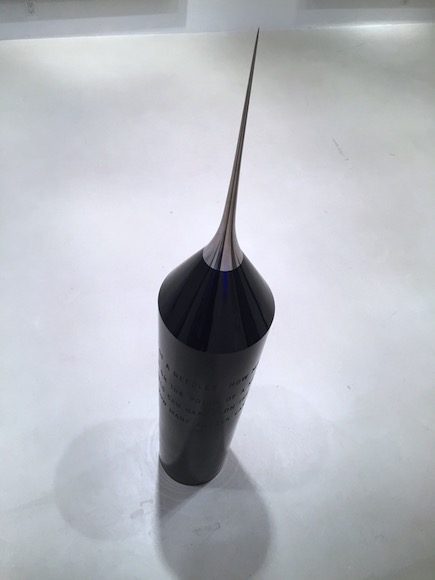
Lamentations:How Many Angels Can Dance on the Point of a Needle?
Installation view
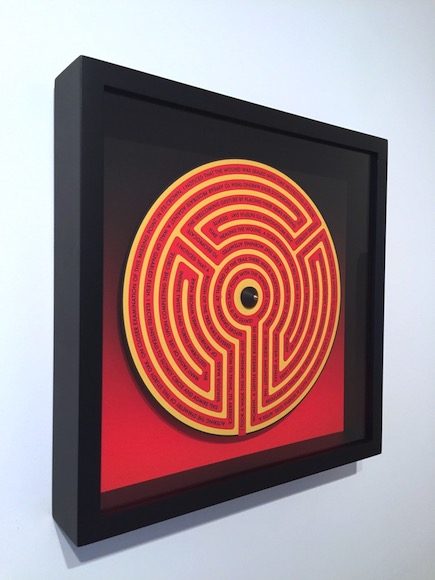
A Note to Paula
Installation view
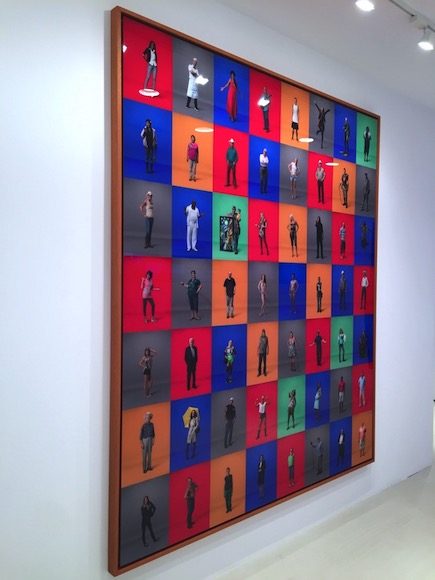
America in Color, Matrix
Installation view

installation view
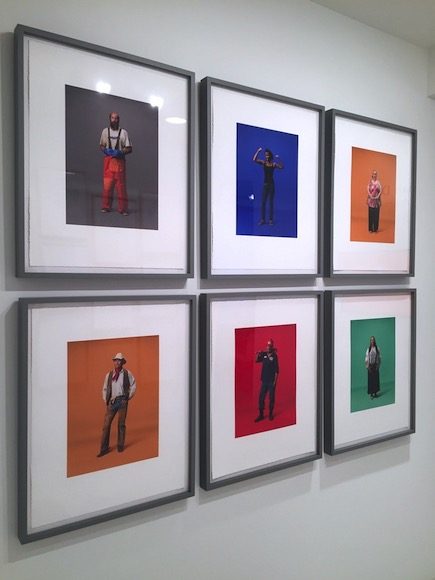
America in Color
Installation view

WORDS
Installation view
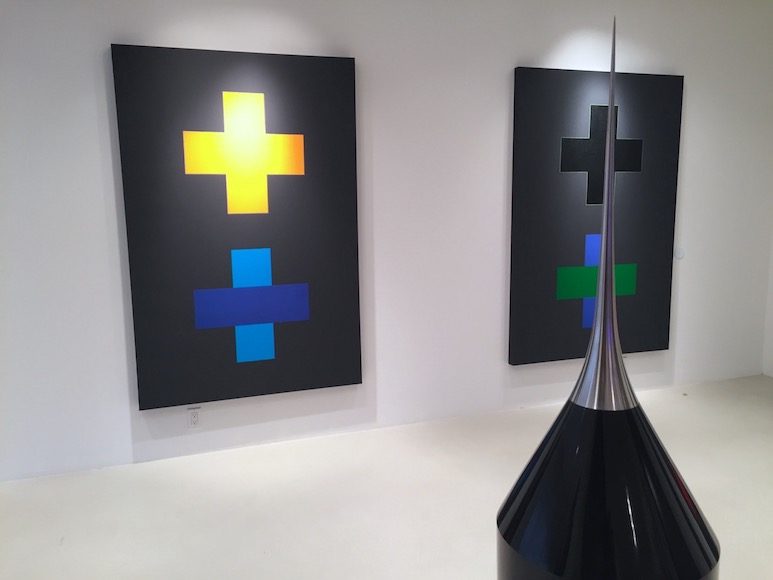
installation view

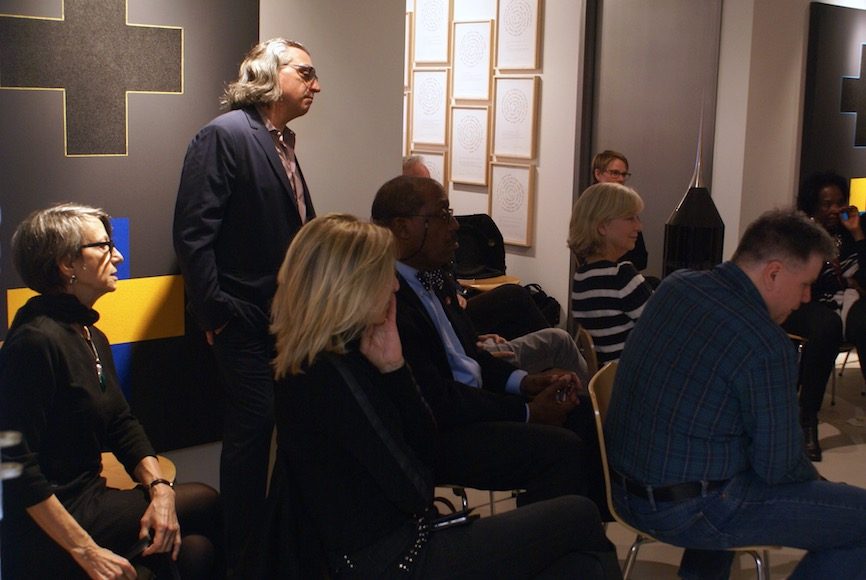

Baahng Gallery is pleased to announce representation of Brian Dailey and the presentation of his first solo exhibition in the gallery, Polytropos. The exhibition features selected works from 2010 to 2018 and debuts to a New York audience his most recent monumental project WORDS, an expansive global video installation engaging with issues of language and identity under globalization.
Based in Washington D.C., Dailey is an artist whose work in a range of media, including photography, film, installations, and painting, draws on his unconventional evolution as an artist and reflects pressing concerns of our times. His conceptual and performance based art expands the parameters in which he works, defying easy categorization
.
Perhaps no word better characterizes Dailey than polytropos, the first adjective Homer applies to Odysseus in The Odyssey. Translated from the Greek as well traveled, much wandering, and, in a more metaphorical sense, as the man of many twists and turns, polytropos suitably describes Dailey’s life journey. His many peregrinations have taken him from his art studies and career in Los Angeles in the 1970s to a twenty-year interlude working on arms control and international security, ultimately bringing him full circle back to his roots as an artist. These unusual experiences, which he approached with the same curiosity that has driven his art, provide a fertile source of inspiration in his idiosyncratic creative practice.
Dailey’s multifaceted background is reflected in works in the exhibition such as the meditative and provocative two- and three-dimensional works from his Lamentations series, a pioneering project that manifests a novel aesthetics of nuclear iconography in post-Cold War and in the elegant and vibrant canvases from his autobiographical 14 Stations at the Crossroads, an engaging series that revisits key moments in the artist’s life journey. Equally reflective of his life experiences are the radiant and intricate digital graphite drawings, Riddles, embedded with compelling multifaceted meanings. Also on view is the dynamic mosaic of photographic portraits from Dailey’s America in Color project, a color-coded time capsule of the myriad faces of the U.S. populace, situated literally and symbolically against a backdrop of the contemporary political landscape.
Brian Dailey has had solo exhibitions in Los Angeles, New York, Washington, D.C., and Bulgaria, and participated in a number of group shows in the United States, Europe, and Russia. His most recent museum exhibition, WORDS, was held at Katzen Arts Center, American University Museum in Washington D.C. in 2018, and his mid-career retrospective took place at Bulgaria’s National Art Gallery in Sofia in 2014. The evocative video Jikai–which will be on view at the gallery—was screened on multiple synchronized monitors in New York City in February, 2014, as the featured video in the Times Square Midnight Moment series; a project of ART PRODUCTION FUND.
Brian Dailey: Polytropos
A solo exhibition by Brian Dailey
November 1 – Dec 15, 2018
Opening reception
6-8PM, Thursday November 1, 2018
6PM, November 8, 2018
Related:

Brian Dailey at The Rachel M. Schlesinger Arts Center
Categories: exhibitions
Tags: Brian Dailey
CAGE NAM JUNE: A Multimedia Friendship
Curated by Kenneth Silverman
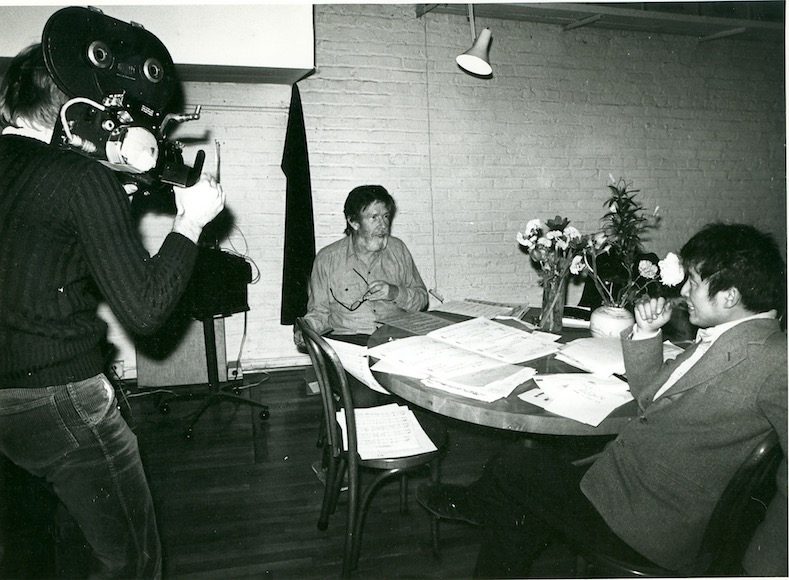
Photo: The John Cage Trust and the John Cage Collection, Northwestern University Music Library
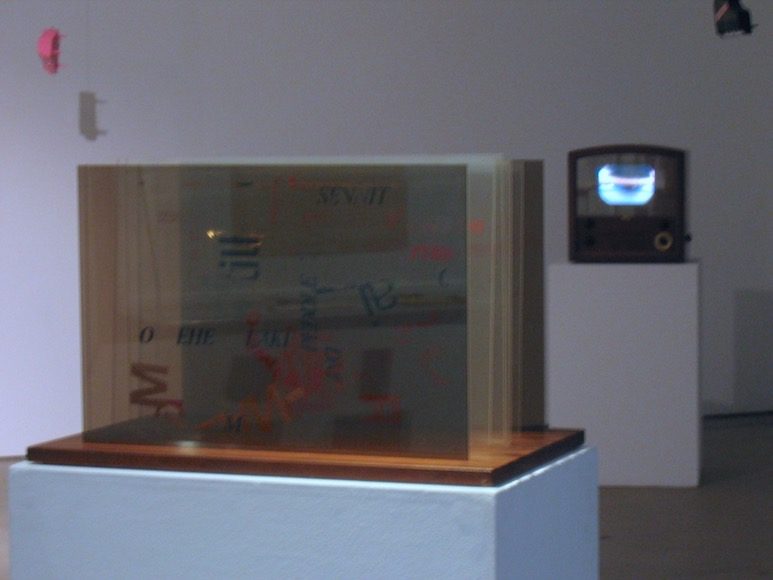
Installation view
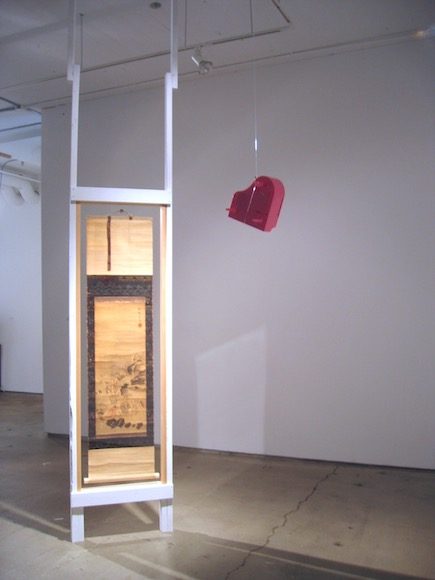

Nam June Paik, 1965
William S. Wilson Archive

Nam June Paik
Mixed media on antique scroll
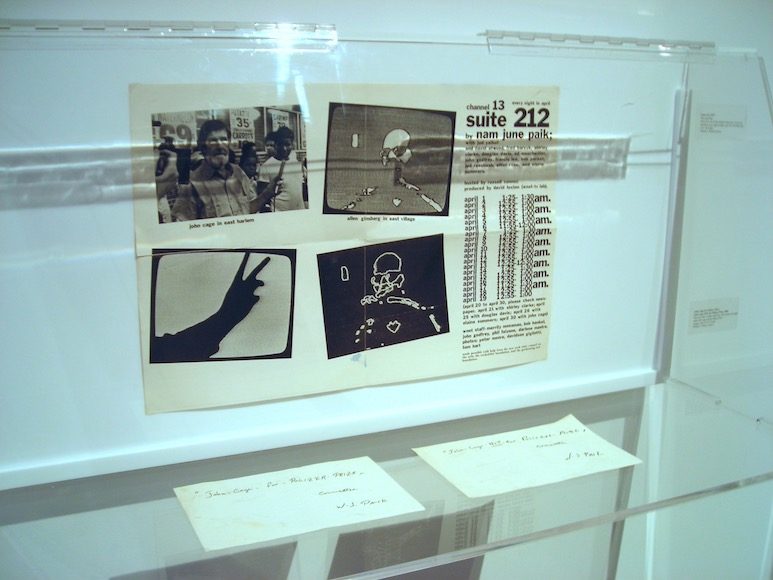
Suite 212, 1977
Poster for a set of film sketches about New York to be broadcast every night in April; April 30 with John Cage
John Cage for Pulitzer Prize, John Cage NOT for Pulitzer Prize, 1965
Nam June Paik’s double-sided flyer with contrary messages about John Cage and the Pulitzer Prize
William S. Wilson Archive

Directed by Elliot Caplan
Excerpt from Cage/Cunningham in which Nam June Paik talks about cutting off John Cage’s necktie
Courtesy of Cunningham Dance Foundation
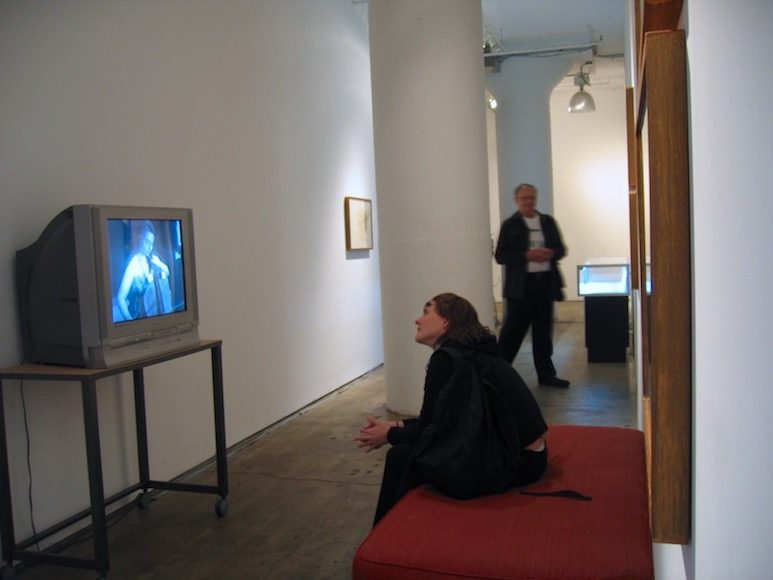
Filmed by Ira Schneider
Courtesy of Shigeko Kubota
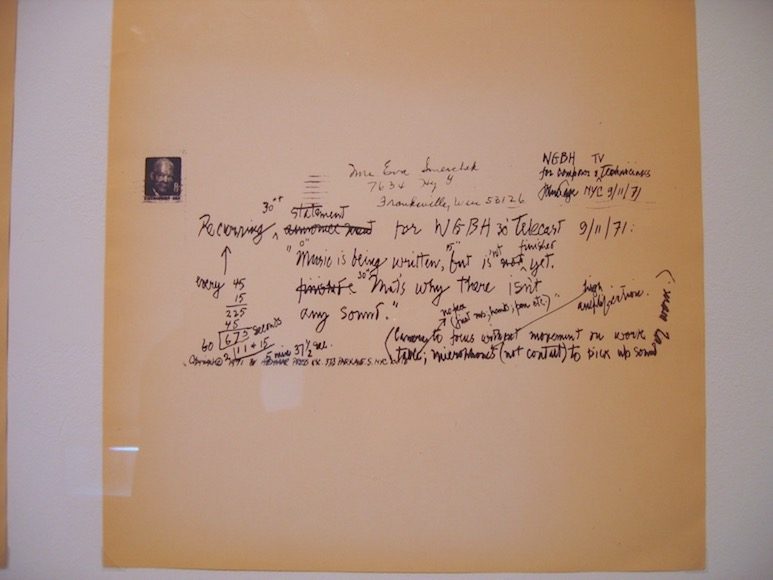
John Cage
Correspondence and notes regarding WGBH-TV, a composition for TV that John Cage dedicated to Nam June Paik
New York City and Cambridge, Mass, September 1971
Courtesy of C.F. Peters Corporation
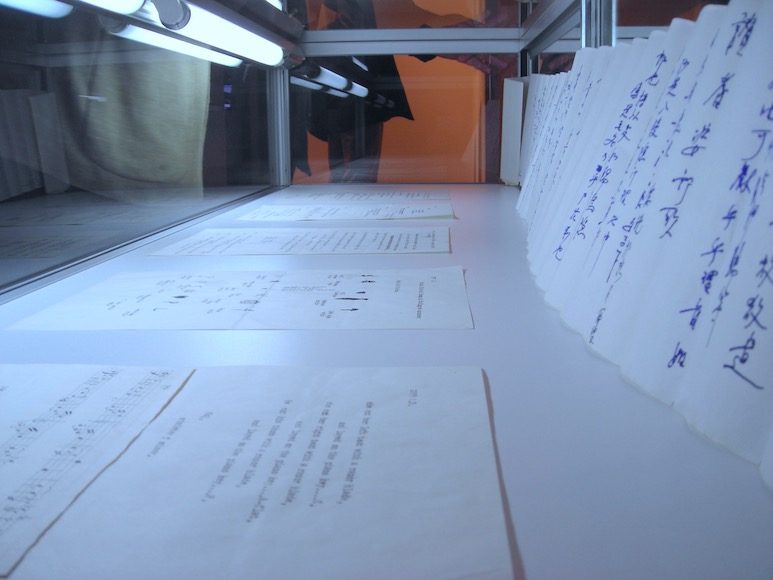
William S. Wilson Archive
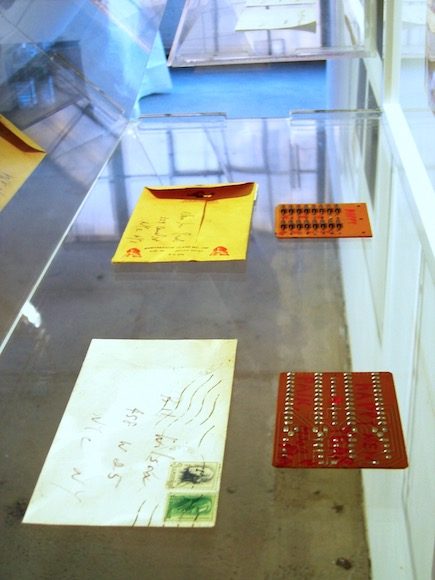
Nam June Paik’s New Years greeting card to William S. Wilson
Acrylic on circuit board
William S. Wilson Archive
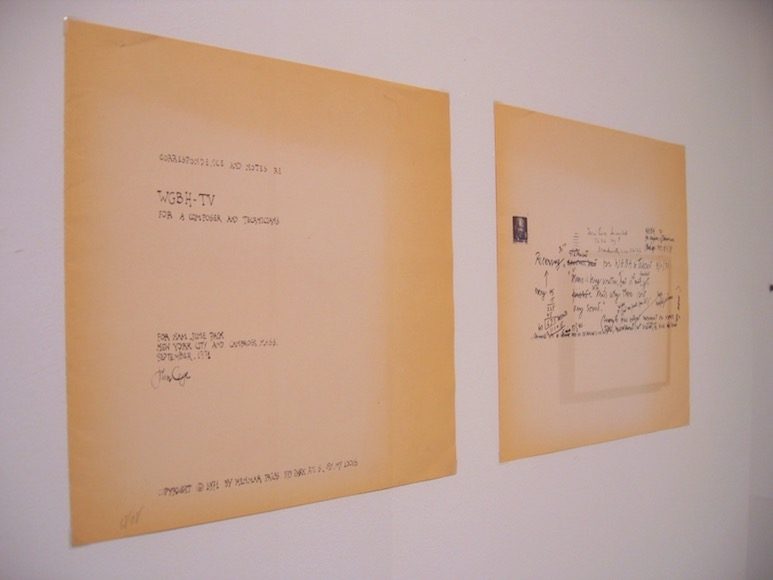
John Cage
Correspondence and notes regarding WGBH-TV, a composition for TV that John Cage dedicated to Nam June Paik
New York City and Cambridge, Mass, September 1971
Courtesy of C.F. Peters Corporation

As part of its Homage to Nam June Paik series, ZONE: Chelsea Center for the Arts celebrates the nearly thirty-five year association between Nam June Paik and John Cage– two uniquely inventive and versatile creators.
In representing the association of these two joyously adventurous artists, ZONE: Chelsea Center for the Arts will exhibit representative scores, videos, music, drawings, photographs, writings, installations, video sculpture, objets sonores, and conceptual art. At the opening night performance on October 5, 7pm, the renowned Cage interpreter, Margaret Leng Tan, will celebrate the Cage-Paik legacy with her toy piano/toy instrumental Hommage à John Cage/Nam June Paik. In addition to the opening night’s event, the gallery will host a panel discussion on October 19, 7pm. The panel consists of the Fluxus artist Alison Knowles, the dancer and dance historian David Vaughan, the vocalist/composer Joan La Barbara and the writer and critic William S. Wilson, four people who knew and worked with Cage and Paik.
October 5 – November 3, 2006
Opening reception:
Thursday October 5th, 2006
6-8pm
with performance by Margaret Leng Tan
Panel discussion on October 19, 2006
7pm, with
Alison Knowles
David Vaughan
Joan La Barbara
William S. Wilson
Kenneth Silverman
ZONE: Chelsea Center for the Arts celebrates the nearly thirty-five year association between John Cage and Nam June Paik. Uniquely adventurous and versatile creators, they worked in music, video, radio, writing, sculpture, film, drama, dance, and graphic arts.
Their pasts make the association seem at first unlikely. Born in Los Angeles, the grandson and great-grandson of Methodist ministers, Cage was a college dropout, twenty years older than Paik. Born in Seoul, Korea, to wealthy owners of a textile company, Paik completed a graduate dissertation at the University of Tokyo.
The differences marked their earliest contacts. They met in 1958 at the annual International Holiday Courses for New Music in Darmstadt, Germany. As a composer, Cage was already well known for his use of chance operations based on an ancient Chinese text. Having heard that the American called upon Asiatic thought, Paik attended Cage’s concert, he later confessed, with a “very cynical mind.”
Cage had early misgivings about Paik, too. In 1960 he attended a performance in Cologne of Paik’s “Etude for Pianoforte.” After playing a few minutes of Chopin, Paik picked up long scissors and jumped off the stage to where Cage was sitting. Then, as Cage recalled the event, Paik “cut off my tie and began to shred my clothes, as if to rip them off of me.” After also pouring over Cage a bottle of shampoo, Paik barged through the crowd and out the door. The ‘Etude,’ Cage said, left him with a “grim memory” of Paik.
Yet they came to intensely enjoy and admire each other. As Paik continued listening to Cage’s music in Darmstadt, he recalled, “slowly, slowly I got turned on. At the end of the concert I was a completely different man.” In his 1991 Two Teachershe remarked that “Cage means ‘bird cage’ in English, but he didn’t lock me up; he liberated me.” The violence in some of Paik’s performance art—e.g. smashing a violin to bits–remained foreign to Cage, who abhorred violence. Still, when asked what he would miss most if he died tomorrow, he reportedly replied: “The conversation of Nam June Paik.”
They especially drew together after 1964, when Paik moved to New York City, settling into a loft in Soho. He loved the city, as did Cage. Much as Cage fed into a live electronic piece open telephone lines from Luchow’s Restaurant and Con Edison’s 14thstreet power station, Paik created a set of film sketches about New York, Suite 212 (1977), his title invoking the city’s area code. Cage introduced him around town, and they worked with many of the same people–Laurie Anderson, Joseph Beuys, Merce Cunningham. Paik also performed in concerts and events by Fluxus, the Dada-ish group born out of Cage’s experimental composition classes at the New School.
And when apart they often corresponded. Paik-like, Paik sometime sent banal postcards that he comically transformed by funny drawings and cartoons. Once he mailed Cage a greeting card made of bank receipts for bum checks he had written. “Your writing is superb,” Cage replied. “Send me the least little thing you write.”
Paik remains best known, of course, for seeing early on and then exploring the artistic possibilities of television. His 1963 show at a gallery in Wuppertal, Germany, was the first exhibition anywhere of Video art. Later he helped develop the video synthesizer; translating electronic impulses into abstract colors and shapes, it made the cathode ray tube a canvas. Among his many other video creations are human-shaped sculptures built out of TV monitors, including a video sculpture of Cage. The New York Timesart critic John Canaday called him the “John Cage of the ordinary domestic TV set.”
A performer by nature—like Paik—Cage appeared on such popular early television programs as The Henry Morgan Showand I’ve Got A Secret; the Italian TV version of Double or Nothing (as a contestant); and on one of the earliest cable TV programs. He eagerly lent himself to Paik’s many video films. In Paik’s Global Groovehe tells an anecdote; A Tribute to John Cageshows him seated outdoors in Harvard Square, not-playing 4’33”. For Paik’s ambitious Good Morning Mr. Orwell—a one-hour TV show transmitted by satellite between New York and Paris—Cage not only appeared but also made a lithograph to be sold by Paik in raising the million-dollar production cost.
Cage particularly admired Paik’s Zen for Film—sixty minutes of shapeshifting specks of dust. He preferred it, he said, “to any film I’ve ever seen before or after. It’s one of the great films.” Paik could be an equally ardent fan, He imagined establishing a Laser TV station to broadcast nothing but John Cage.
The current exhibition at ZONE: Chelsea offers some of the looks and sounds of this multimedia friendship—representative scores, music, videos, drawings, photographs, writings, installations, video sculpture, objets sonores, and conceptual art.
Kenneth Silverman
Kenneth Silverman is Professor Emeritus of English at New York University. His books include Timothy Dwight; A Cultural History of The American Revolution; The Life and Times of Cotton Mathe; Edgar A. Poe Mournful and Never-ending Remembrance; HOUDINI!!!.; and Lightning Man: The Accursed Life of Samuel F. B. Morse. A fellow of the American Academy of Arts and Sciences, he has received the Bancroft Prize in American History, the Pulitzer Prize for Biography, the Edgar Award of the Mystery Writers of America, and the Christopher Literary Award of the Society of American Magicians. Currently he is writing a biography of John Cage.
SPOTLIGHT
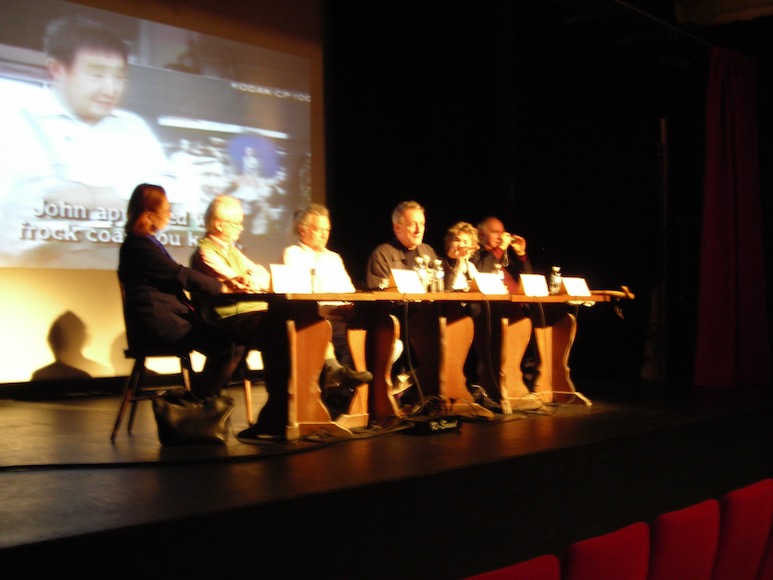
Panel Discussion in Paris, Moderated by George Quasha
Saturday, October 28th 2006, 6pm
Accompanying the exhibition, CAGE NAM JUNE: A Multimedia Friendship, ZONE: Chelsea Center for the Arts presents:
Panel Discussion in Paris during Digital Video Art Fair
Moderated by George Quasha
Saturday, October 28th, 2006
6pm at Theatre La Reine Blanche
2 bis passage Ruelle, 75019 Paris, France
Panelists:
Born in France, Jackie Matisse lived in New York until 1954. Since then she has lived in Paris making frequent visits to New York. Between 1959 and 1968 she worked for Marcel Duchamp, completing the assemblage of the “Boite en Valise”. At this time using her married name, Jacqueline Monnier, she began to make kites “in order to play with color and line in the sky”. In 1980 she showed kites which were created to be used underwater at the Betty Parsons Gallery in New York, and since then has continued to make kitelike objects intended for three different kinds of space: the sky, the sea, and indoor space, all linked through her use of movement.
Charles Stein is the author of Persephone Unveiled (a study of the Eleusinian Mysteries), eleven books of poetry including The Hat Rack Treeand the forthcoming From Mimir’s Headfrom Station Hill /Barrytown, Ltd., a long-term poetic project, theforestforthetrees, translations of Greek epic, philosophical, and Hermetic poetry; a critical study of the poet Charles Olson and his use of the writings of C.G. Jung called The Black Chrysanthemum(also from Station Hill Press). His work has been anthologized in such collections as Poems for the Millennium (U. of California Press), Hazy Moon Enlightenment(Shambala),Technicians of the Sacred(U. of California Press),Text-Sound Texts(Morrow), Open Poetry(Simon and Schuster) and has appeared in such magazines as American Poetry Review, Alcheringa, Caterpillar, Conjunctions, Ear Magazine, Perspectives of New Music, Temblor, Sulphur, Open Space,and many other poetry journals. He was the editor of an anthology Being=Space X Action: Searches for Freedom of Mind in Art, Mathematics and Mysticism.
He received an Individual Writer’s Grant from the National endowment for the Arts for 1978-79, and was the winner of the Wallace Stevens Poetry Prize in 1973.
He plays Gregory Bateson in video-installation artist Gary Hill’sWhy Do Things Get in a Muddle?and is one of the two performers (with George Quasha) in Gary Hill’s Tale Enclosure. He collaborated with Gary Hill and Paulina Wallenberg-Olsson in the creation of Dark Resonances—a performance/installation at the Colosseum in Rome. For three decades he has worked with George Quasha in the production of “dialogical” critical texts, including three books: Hand Heard/liminal objects: Gary Hill’s Projective Installations—Number 1, Tall Ships: Gary Hill’s Projective Installations—Number 2,and Viewer: Gary Hill’s Projective Installations—Number 3.His other collaborative writing with George Quasha related to Gary Hill’s work has appeared in art catalogues of the Stedelijk Museum of Amsterdam, the Kunsthalle of Vienna, the Barbara Gladstone Gallery of New York, Public Access of Toronto, the Voyager Laserdisc Gary Hill, etc.
In collaboration with Gary Hill and George Quasha, he has performed at the Long Beach Museum of Art, California, The Museum of Modern Art, Oxford, England, The Rhinebeck Performing Arts Center.
As a multi-media artist and “Sound Poet” his graphic “Text-Sound Texts” have been anthologized and performed by himself and others; his drawings have appeared as accompaniments to his own poetry. He has performed his sound poetry at the International Sound Poetry Festival, The New Moon Festival, The New Image Theater, as well as at numerous University sponsored, music, and literary venues.
His photography has appeared in exhibitions at The College Art Gallery of SUNY New Paltz, The University of Connecticut Library in Storrs, The Arnolfini Arts Center in Rhinebeck, New York, the Robert Louis Stevenson School in New York, New York, and on the covers of numerous books of poetry and fiction.
He holds a Ph.D. in literature and has taught at SUNY Albany, Bard College’s Music Program Zero, and The Naropa Institute.
He currently resides in Barrytown, New York.
Gary Hill is one of the most important contemporary artists investigating the relationships between words and electronic images — an inquiry that has dominated the video art of the past decade. Originally trained as a sculptor, Hill began working in video in 1973 and has produced a major body of single-channel videotapes and video installations that includes some of the most significant works in the field of video art. His first tapes explored formal properties of the emerging medium, particularly through integral conjunctions of electronic visual and audio elements.
His installations and tapes have been seen throughout the world, in group exhibitions at The Museum of Modern Art, New York; Centre Georges Pompidou, Paris; Documenta 8, Kassel, West Germany; Long Beach Museum of Art, California; Stedelijk Museum, Amsterdam, and the Video Sculpture Retrospective 1963-1989, Cologne, West Germany, among other festivals and institutions. Hill’s work has also been the subject of retrospectives and one-person shows at The American Center, Paris; Whitney Museum of American Art, New York; 2nd International Video Week, St. Gervais, Geneva; Musee d’Art Moderne, Villeneuve d’Ascq, France; and The Museum of Modern Art, New York.
Gary Hill created new large scale works for his solo exhibition at the Fondation Cartier pour l’art contemporain in Paris, October 27, 2006 – February 4, 2007.
.
Molly Davies started making experimental films in the late 1960s in New York City. For multi media performance pieces she has collaborated with artists including John Cage, David Tudor, Takehisa Kosugi, Lou Harrison, Michael Nyman, Alvin Curran, Fred Frith, Suzushi Hanayagi, Sage Cowles, Polly Motley, Jackie Matisse and Anne Carson. Her work has been presented at such sites as the Venice Film Festival, the Centre Pompidou, Musee de l’Art Moderne de la Ville de Paris, Musee Art Contemporain Lyon, The Getty, Theatre Am Turm, the Whitney Museum, the Walter Arts Center, the Kitchen, La Mama Etc., Dance Theatre Workshop, Jacob’s Pillow Dance Festival and the Indonesian Dance Festival. Her work is in the collections of the Getty Research Institute, the Musee Art Contemporain Lyon and the Walker Art Center. She teaches courses in design for inter-media performances at universities in the United States, Europe and Asia.
Artist and poet George Quasha works across mediums to explore principles in common within language, sculpture, drawing, video, sound, installation, and performance. His axial stones and axialdrawingshave been exhibited in New York’s Chelsea at Baumgartner Gallery and ZONE Chelsea Center for the Arts, and elsewhere, and are featured in the newly published book, Axial Stones: An Art of Precarious Balance(Foreword by Carter Ratcliff) (North Atlantic Books: Berkeley).
For his video installation art is: Speaking Portraits (in the performative indicative),he has filmed some 500 artists, poets, and composers (in 7 countries and 17 languages) saying “what art is.” His video works (including Pulp Friction, Axial Objects, Verbal Objects) have appeared internationally in museums, galleries, schools, and biennials. A 25 year performance collaboration (video/language/sound) continues with Gary Hill and Charles Stein.
In 2006 he was awarded a Guggenheim Fellowship in video art.
His other 14 books include poetry (Somapoetics, Giving the Lily Back Her Hands,Ainu Dreams [with Chie Hasegawa],Preverbs); anthologies (America a Prophecy [with Jerome Rothenberg], Open Poetry[with Ronald Gross],An Active Anthology[with Susan Quasha], TheStation Hill Blanchot Reader); and writing on art (Gary Hill: Language Willing;with Charles Stein: Tall Ships, HanD HearD/liminal objects,Viewer).
Awards include a National Endowment for the Arts Fellowship in poetry. He has taught at Stony Brook University (SUNY), Bard College, the New School, and Naropa University. With Susan Quasha he is founder/publisher of Barrytown/Station Hill Press in Barrytown, New York.

Panel Discussion, Moderated by Kenneth Silverman
Thursday, October 19th 2006, 7pm
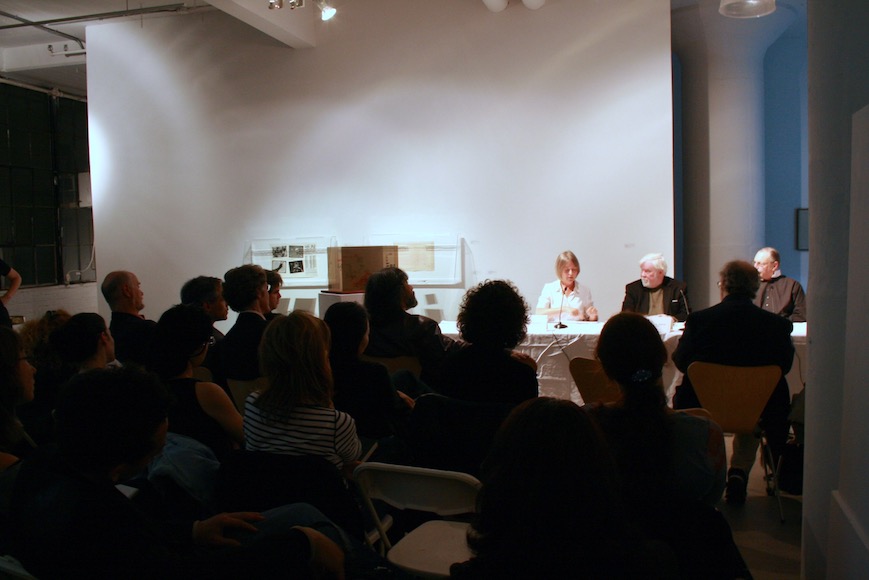
Panel Discussion, Moderated by Kenneth Silverman
Thursday, October 19th 2006, 7pm

Panel Discussion, Moderated by Kenneth Silverman
Thursday, October 19th 2006, 7pm

Panel Discussion, Moderated by Kenneth Silverman
Thursday, October 19th 2006, 7pm
Accompanying the exhibition, CAGE NAM JUNE: A Multimedia Friendship, ZONE: Chelsea Center for the Arts presents a Panel Discussion with four people who knew and worked with Cage and Paik.
Thursday, October 19th, 200 at 6:30 pm
Panelists:
the Fluxus artist Alison Knowles
vocalist/composer Joan La Barbara
dancer and dance historian David Vaughan
writer and critic William S. Wilson
curator Kenneth Silverman
ALISON KNOWLES was born in New York City. She works in the field of visual art, making performances, sound works and radio shows (Hoerspiele). She attended Scarsdale High School, Middlebury College and graduated with an honors degree in Fine Art from Pratt Institute in Brooklyn. She married the Fluxus artist Dick Higgins and worked for the Something Else Press doing special editions by silkscreen, engaged in events with the Fluxus group and birthed twin daughters Hannah B and Jessica in 1964. Her installation The Big Book was made in New York, and toured in Canada and Europe, collapsing in California in the mid-seventies. For three years she was Associate Professor of Art at California Institute of the Arts in the department of Alan Kaprow. Her computer instigated dwelling The House Of Dust is located in California as a permanent installation. During the late seventies and eighties she extended her studio to include a shop in Barrytown, New York, a stone’s throw from the Hudson River. During the eighties she has worked in Italy and Germany and Japan doing multiples, unique pieces and radio plays. Her second walk-in book The Book Of Bean from 1983 appeared in Venice. Her most recent exhibitions include “Um-Laut” in Koln and “Indigo Island” in Warsaw. She maintains a studio at 122 Spring St. in New York.
DAVID VAUGHAN was born in London and educated at Oxford University. He studied ballet with Marie Rambert and Audrey de Vos. In 1950 he continued his studies at the School of American Ballet, later studying with Antony Tudor, Richard Thomas, and Merce Cunningham. He has worked as a dancer, actor, singer, and choreographer, on film and television, in ballet and modern dance companies, and in cabaret. He is associate editor of Ballet Review and the Encyclopaedia of Dance and Ballet. He is the author of Frederick Ashton and His Ballets and the forthcoming Merce Cunningham: 50 Years, for which he received a Guggenheim Fellowship; and he has contributed to Dancers on a Plane: Cage, Cunningham, Johns and to Ornella Volta’s Satie et Ia danse. He has been associated with Merce Cunningham Dance Company since 1959, as archivist since 1976. He has taught dance history and criticism at New York University, the State University of New York/College at Purchase, the Laban Centre for Movement and Dance, the University of Chicago Dance History Seminar, and the American Dance Festival Critics’ Conference. In 1986 he was Regents’ Lecturer at the University of California.
JOAN LA BARBARA was born in Philadelphia, PA. Educated at Syracuse and New York Universities and Tanglewood/Berkshire Music Center, studying voice with Helen Boatwright, Phyllis Curtin and Marian Szekely-Freschl, she learned her compositional tools as an apprentice with the numerous composers with whom she has worked for three decades. Her career as a composer/performer/soundartist explores the human voice as a multi-faceted instrument expanding traditional boundaries, creating works for multiple voices, chamber ensembles, music theater, orchestra and interactive technology, developing a unique vocabulary of experimental and extended vocal techniques: multiphonics, circular singing, ululation and glottal clicks that have become her “signature sounds”, garnering awards in the U.S. and Europe. La Barbara has collaborated with artists including Lita Albuquerque, Cathey Billian, Melody Sumner Carnahan, Judy Chicago, Ed Emshwiller, Kenneth Goldsmith, Peter Gordon, Bruce Nauman, Steina, Woody Vasulka and Lawrence Weiner. In the early part of her career, she performed and recorded with Steve Reich, Philip Glass and jazz artists Jim Hall, Hubert Laws, Enrico Rava and arranger Don Sebesky, developing her own unique vocal/instrumental sound. In addition to the internationally-acclaimed “Three Voices for Joan La Barbara by Morton Feldman” “Joan La Barbara Singing through John Cage” and “Joan La Barbara/Sound Paintings”, she has recorded for A&M Horizon, Centaur, Deutsche Grammophon, Elektra-Nonesuch, Mode, Music & Arts, MusicMasters, Musical Heritage, Newport Classic, New World, Sony, Virgin, Voyager and Wergo. Recording projects as singer and/or producer include “Only: Works for Voice and Instruments” by Morton Feldman”; “Rothko Chapel/Why Patterns”, “John Cage at Summerstage with Joan La Barbara, Leonard Stein and William Winant”, Cage’s final concert performance on July 23, 1992 in NYC’s Central Park. La Barbara was Artistic Director of the Carnegie Hall series, “When Morty met John”, celebrating the music of John Cage and Morton Feldman and The New York School; is Artistic Director, Curator and Host of “Insights”, a new series of encounters with distinguished composers, for The American Music Center; and co-produces the “EMF 10” concert series in New York City. Joan La Barbara is a member of SAG, AFTRA, AEA, The American Music Center, and is a composer and publisher member of ASCAP.
WILLIAM S. WILSON, who was graduated with a Ph.D. from Yale University, has taught the writing of fiction at Queens College and the Graduate Writing Division of Columbia University. Author of a book of short stories, Why I don’t write like Franz Kafka, he has been writing essays about visual art since 1964. Nam June Paik lived in a studio in his house during1964-65. He has given talks about Eva Hesse in Paris, London, San Francisco and New York.
KENNETH SILVERMAN – Curator Kenneth Silverman is Professor Emeritus of English at New York University. His books include Timothy Dwight; A Cultural History of the American Revolution; The Life and Times of Cotton Mathe; Edgar A. Poe: Mournful and Never-ending Remembrance; HOUDINI!!!.; and Lightning Man: The Accursed Life of Samuel F. B. Morse. A fellow of the American Academy of Arts and Sciences, he has received the Bancroft Prize in American History, the Pulitzer Prize for Biography, the Edgar Award of the Mystery Writers of America, and the Christopher Literary Award of the Society of American Magicians. Currently he is writing a biography of John Cage.

Hommage to John Cage and Nam June Paik by Margaret Leng Tan
Thursday, October 5th 2006, 7pm
Accompanying the exhibition, CAGE NAM JUNE: A Multimedia Friendship, at the opening night performance on October 5, 7pm, the renowned Cage interpreter, Margaret Leng Tan, celebrate the Cage-Paik legacy with her toy piano/toy instrumental Hommage to John Cage/Nam June Paik.
Thursday, October 5th, 2006 at 7 pm
Program
HOMMAGE to JOHN CAGE/NAM JUNE PAIK
by
MARGARET LENG TAN
toy piano, toy instruments
HOMMAGE to NAM JUNE PAIK (2006) – first performance
Margaret Leng Tan
SUITE FOR TOY PIANO (1948)
John Cage
4′ 33″ (1952
John Cage
from OLD McDONALD’S YELLOW SUBMARINE (2004) – BICYCLE LEE HOOKER toy piano, bicycle bell and horn, train whistle
Erik Griswold
CHOOKS – toy piano and wood blocks
Margaret Leng Tan
5’29.75″ FOR SIX TOY PLAYER PIANOS / Elegy for Nam June (2006) – first performance
Erik Griswold
STAR-SPANGLED ETUDE #3 (“Furling Banner”) (1996) – toy piano, siren, whistle, cap gun
Raphael Mostel
Margaret Leng Tan has established herself as a major force within the American avant-garde; a highly visible, talented and visionary pianist whose work sidesteps perceived artificial boundaries within the usual concert experience and creates a new level of communication with listeners. Embracing aspects of theater, choreography, performance and even “props” such as the teapot she “plays” in Alvin Lucier’s Nothing is Real,Tan has brought to the avant-garde, a measure of good old-fashioned showmanship tempered with a disciplinary rigor inherited from her mentor John Cage. This has won Tan acceptance far beyond the norm for performers of avant-garde music, as she is regularly featured at international festivals, records often for adventurous labels such as Mode and New Albion and has appeared on American public television, Lincoln Center and even at Carnegie Hall.
Born in Singapore, Tan was the first woman to earn a doctorate from Juilliard, but youthful restlessness and a desire to explore the crosscurrents between Asian music and that of the West led her to Cage. This sparked an active collaboration between Cage and Tan that lasted from 1981 to his death, during which Tan gained recognition as one of the pre-eminent interpreters of Cage’s piano music, partly through her New Albion recordings, Daughters of the Lonesome Isleand The Perilous Night/Four Walls. After Cage’s death in 1992, she was chosen as the featured performer in a tribute to his memory at the 45th Venice Biennale.
Tan takes a lively interest in the musical potential of unconventional and unlikely instruments, and in 1997 her groundbreaking CD, The Art of the Toy Piano on Point Music/Universal Classics elevated the lowly toy piano to the status of a “real” instrument. Tan is certainly the world’s first, and so far, only professional toy piano virtuoso. Since then her curiosity has extended to other toy instruments as well, substantiating her credo “Poor tools require better skills” (Marcel Duchamp).
Tan favors music that confronts and defies the established boundaries of the piano and her toy instruments and has collaborated with like-minded composers to create works for her, such as Somei Satoh, Tan Dun, Michael Nyman, Julia Wolfe, Toby Twining and Ge Gan-ru; she is also a favorite of composer George Crumb. Tan’s authority on matters of Cage has evolved from that of an expert interpreter to responsible scholar protecting the textual integrity of his work; Tan edited the fourth volume of Cage’s piano music for C. F. Peters and in 2006 gave the premiere of his newly discovered 1944 work Chess Pieces, which she also edited for publication. Tan’s Mode DVD of Cage’s Sonatas and Interludes includes a video in which she examines the original, 1940s era preparation materials for the work. Photogenic and comfortable with the camera, Tan is the subject of a feature documentary by filmmaker Evans Chan, Sorceress of the New Piano: The Artistry of Margaret Leng Tan,which receives its New York premiere at the Pioneer Two Boots Theater on September 23/24.
Related:
Categories: exhibitions
Tags: CAGE NAM JUNE
MOLLY DAVIES

Invitation card

Desire
Video/sound installation
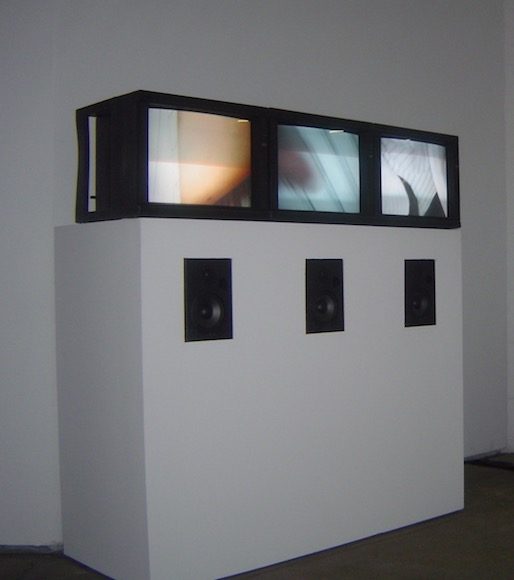
Dressing
Installation view
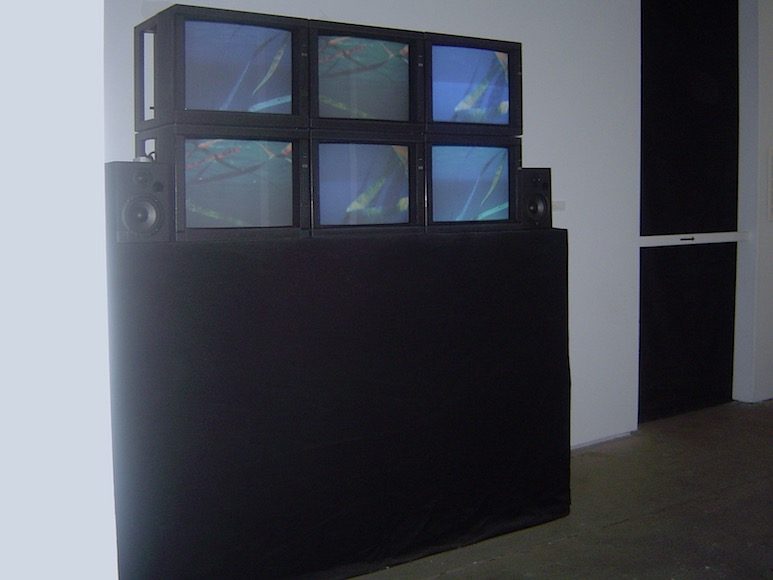
Sea Tails
Installation view

Desire
Installation view

Pastime
Slide/video/sound installation
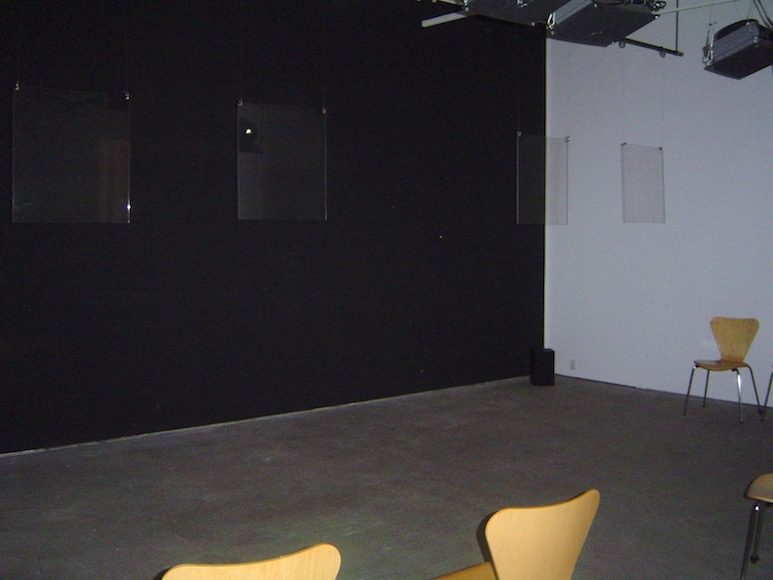
Pastime
Installation view

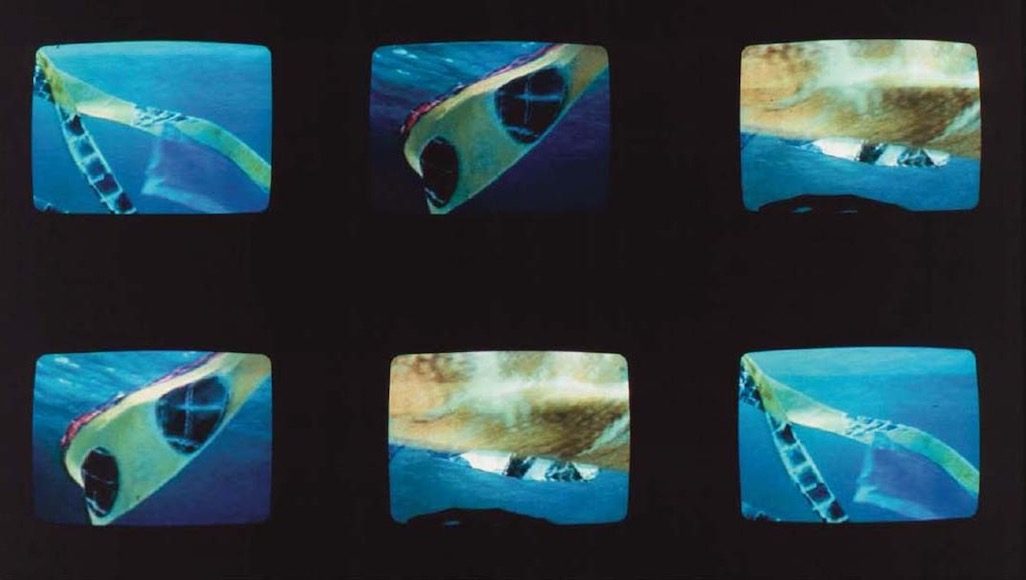
Sea Tails
Video/sound installation


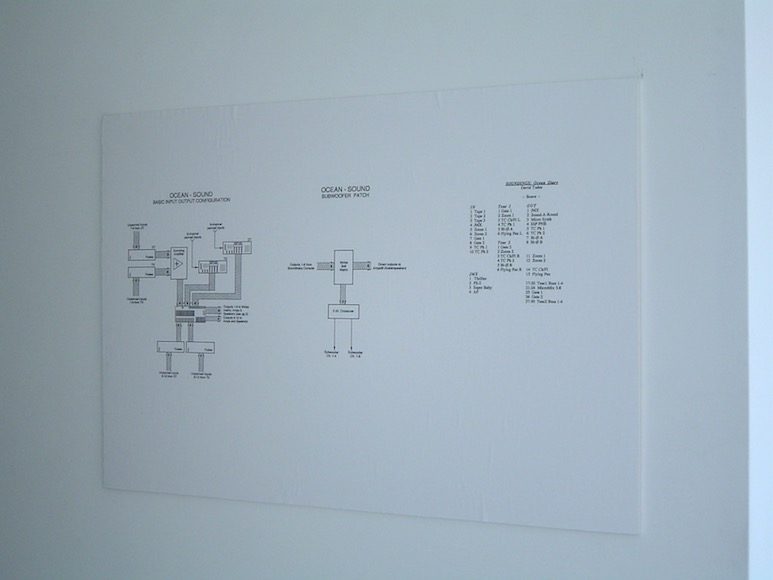
Zone: Chelsea Center for the Arts is proud to present a retrospective of video installation works by artist Molly Davies. A film and video artist, Davies started making experimental films in the late 1960s. She became well known in the 1970s for her innovative work with film and performance, collaborating with contemporary choreographers, performers and composers. The exhibition will focus on Davies’ unique collaboration between mediums and will feature four major installation works spanning three decades. The exhibition will also include a screening booth with Davies’ documentary film performance pieces that were made for the theater.
Her work explores movement of the performing body and film, distilling the everyday to suggest undercurrents of desire, isolation and joy. Juxtaposing images to create layers of meaning, her work immerses the viewer into striking, poetic worlds, using multiple projections, screens and monitors to enhance the reflexive, abstract themes within the visual/sound compositions. Noted for her richly textured work, Davies brings the complex, subtle rhythms of movement and time altering medium of video into compelling spatial arrangements to provide multiple perspectives on the nuances of the everyday.
The exhibition includes DAVID TUDOR’S OCEAN (1994), a six-channel piece, documenting three performances of the first tour of Merce Cunningham Dance Company’s acclaimed work Ocean, with composer David Tudor and Takehisa Kosugi performing live. This video/sound installation presents a portrait of David Tudor, detailing process and accumulation. It is a meditation on the elaborate tableau of electronic music making in relation to the parallel dance making of Merce Cunningham. The installation takes an imaginative behind-the-scenes look at set-up, rehearsal and live performance. This work is in the permanent collection of the Walker Art Center, The Getty Research Institute and Musée Art Contemporain Lyon. (92 minutes continuous loop)
Also to be shown will be SEA TAILS (1983), a three-channel, six monitor piece, that integrates an evocative electronic score by David Tudor with film footage of French artist Jackie Matisse’s extraordinary underwater kites. This mesmerizing work presents the sculptural patterns of Ms. Matisse’s kites as they float, swirl, and shift gracefully and randomly through the oceans’ current, suspending time and space. Originally presented at the Centre Pompidou in Paris, this piece is in the permanent collection at The Getty Research Institute. (22 minutes continuous loop)
The exhibit will include the premiere of Davies’ work DESIRE(2002), a three-channel, three- screen installation with text by renowned poet Anne Carson. A quiet drama that centers on a day in the life among three friends, DESIRE is imbued with emotional temporal states juxtaposed with a vibrant colorful landscape. The installation uses color video projected side by side on the wall and three-channels of amplified mono sound. (12 minutes continuous loop)
In PASTIME(1995), a provocative slide/video/sound installation built of layers with three projection surfaces and a sound collage, Davies addresses the beauty and poignancy of the quotidian. The installation, like its subject matter, deals with reflection, light, fragments and distortion as the slides and videos constantly dissolve. A woman and a boy wrestle on a raft, playing “king of the mountain”. With gestures that suggest love, conflict, power and eroticism, the work reveals the fragility of the moment, of a certain time in a relationship, of a mid-summer day, and the innocence of coming of age. (12 minutes continuous loop)
The exhibition will include several documentations of film and performances pieces created by Davies from 1976-2005. Among the documented works are Arrivals & Departures(1988); deChirico’s Daughter (1992); Palm at the End of the Mind(1983); Sage Cycle, including Sage Time and Again, Grasslands and Sageand Third Thought(originally created 1976-79, reconstructed in 2005); and Small Circles Great Plains(originally created 1976-79, reconstructed in 2005).
Molly Davies has been working as a film and video artist for over 30 years. For her multimedia performance pieces, she has collaborated with artists John Cage, David Tudor, Michael Nyman, Takehisa Kosugi, Lou Harrison, Alvin Curran, Fred Frith, Suzushi Hanayagi, Sage Cowles, Polly Motley, Jackie Matisse and Anne Carson. Her work has been presented at the Venice Film Festival, the Centre Pompidou, Musée de l‘Art Moderne de la Ville Paris, Musée Art Contemporain Lyon, The Getty, the Whitney Museum, the Walker Art Center, Asia Society, Theatre Am Turm, The Kitchen, Dance Theater Workshop, La MaMa Etc., Jacob’s Pillow Dance Festival, and the Indonesian Dance Festival. She teaches courses in design for inter-media performances at universities in the United States, Europe and Asia.
January 12 – March 11, 2006
Opening reception:
Thursday January 12th, 2006
6-8pm
Reviews
| Asia Society and Museum, New York, NY | TRADITIONS, INVENTIONS, AND EXCHANGE | June 28 through August 21, 2005 |
| Walker Art Center Minneapolis, MN | SPACE, TIME AND ILLUSION- ISSUES OF FILM WITH PERFORMANCE | May 11, 2005 |
| Dance Theatre Workshop New York, NY | SPACE, TIME AND ILLUSION- ISSUES OF FILM WITH PERFORMANCE | April 18 & 19, 2005 |
| Zone Chelsea, New York, NY | DISTANCE BETWEEN GESTURE AND MEANINGS | April 5 through 15, 2005 |
| Smith College, Department of Art North Hampton, MA | DRAWING FROM THE BODY Performance | March 8, 2005 |
| Getty Research Institute Exhibition Gallery Los Angeles, CA | SEA TAILS | July 13 -September 26, 2004 |
| Bates Museum of Art, Lower Gallery at Bates Dance Festival, Lewiston, ME | TRADITIONS, INVENTIONS, AND EXCHANGE | August 9 through 16, 2003 |
| 2002 Bienalle Lyon France Musee Art Contemporain Lyon | DAVID TUDOR’S OCEAN | March, 2002 |
| Texas Gallery Houston, TX | KAREN TAPES | December, 2001 |
| Block Gallery Northwestern University Evanston, IL | PASTIME | September – December, 2001 |
| Getty Museum of Art Los Angeles, CA | DAVID TUDOR’S OCEAN | May, 2001 |
| Argentinian Embassy New York City, NY | DAVID TUDOR’S OCEAN | March, 2001 |
| The New School for Social Research New York City, NY | KAREN TAPES | March 1st, 2001 |
| Tulane University New Orleans, LA | DRAWING FROM THE BODY Performance / Video Installation | February – May, 2001 |
| Mingei International Museum San Diego, CA | SEA TAILS | April – November, 2000 |
| Santa Cruz Museum of Art and History Santa Cruz, CA | MIGRATION DISLOCATION BRANCUSI’S BASKETS | July – November, 2000 |
| The Kitchen New York City, NY | MARGUERITE Summer Residence with Polly Motley | June, 2000 |
| Selby Gallery Sarasota, Florida | “PLUGGED IN” Installations of: DRESSING DISLOCATION BRANCUSI’S BASKETS | March – April, 2000 |
| Mousonturm Frankfurt A/M, Germany | DRAWING FROM THE BODY Performance/ Video Installation | August 24,25, 1999 |
| Flynn Theater Stowe, Vermont | a | June – July, 1999 |
| Jack Tilton Gallery New York, NY | DRAWING FROM THE BODY Performance/Video Installation | February 24, 1999 |
| The Galleries at Moore Philadelphia, PA | SEA TAILS | January 22-March 14, 1999 |
| Jack Tilton Gallery New York, NY | DRAWING FROM THE BODY Performance/ Video Installation | December 10, 1998 |
| Walker Arts Center Minneapolis, MN | DAVID TUDOR’S OCEAN Video Installation | June 28- Sept 21, 1998 |
| Deutschlandfunk Redaktion E-Musik Köln, Germany | DAVID TUDOR’S OCEAN Video Installation | March, 1998 |
| The Kitchen New York, NY | DAVID TUDOR’S OCEAN Video Installation | Oct 30 – Nov 26, 1997 |
| Dancespace New York, NY | IN THE MANNER OF EDWARD HOPPER | October, 1996 |
| Judson Memorial Church New York, NY | DAVID TUDOR’S OCEAN Video Installation | September 17, 1996 |
| Naropa Institute Boulder, CO | BROWNIEFAX | January, 1996 |
| Kitchen Center for Video and Music New York, NY | YOU CAN SING ANY TIME | April, 1995 |
| University of Colorado Boulder, CO | YOU CAN SING ANY TIME | March, 1995 |
| Jacob’s Pillow Dance Festival Lee, MA | FOLK DANCE YOU CAN SING ANYTIME | August, 1994 |
| Movement Research New York, NY | WAITING | December, 1993 |
| Dance Theatre Workshop New York, NY | FOLK DANCE | September, 1993 |
| Naropa Institute Boulder, CO | SUPERFICIAL DISSOLVE | May, 1993 |
| University of Colorado Boulder, CO | DE CHIRICO’S DAUGHTER PART II | May, 1992 |
| Naropa Institute Boulder, Co | DE CHIRICO’S DAUGHTER PART I | February, 1992 |
| Justus Liebig University Giessen, Germany | REICHE OHNE SINNE PROJECT | January – February, 1991 |
| University of Colorado Boulder, CO | COLLABORATION WITH POLLY MOTLEY | April, 1991 |
| Heiner Müller Project Frankfurt, Germany | “BILDBESCHREIBUNG” | April, 1990 |
| La Mama E.T.C. New York, NY | MANA GOES TO THE MOON | January 9-27, 1990 |
| Theatre am Turm Frankfurt, Germany | ARRIVALS AND DEPARTURES | April 20 – 24, 1988 |
| Tampere Theater Festival Finland | ARRIVALS AND DEPARTURES | August 15-16 1988 |
| La Mama E.T.C. New York, NY | ARRIVALS AND DEPARTURES | May 5-29, 1988 |
| Whitney Museum of American Art at Phillip Morris New York City, NY | SEA TAILS | September 17, 1986 |
| The Albuerque Museum of Art, History and Science Albuquerque, New Mexico | SAGE CYCLE Part III SMALL CIRCLES GREAT PLAINS | June 22, 1985 |
| Theatre Am Turm Frankfurt, Germany | ATEM | June 6, 1985 |
| Centre Georges Pompidou Paris, France | Comissionedwork from TAT PALM AT THE END OF THE MIND PREPARING THE GROUND | May 24-26, 1985 |
| Theater am Turm Frankfurt, Germany | Commissioned work from TAT PREPARING THE GROUND | April 18-21, 1985 May 28-31, 1985 |
| Wesleyan College Middletown, CT | SAGE CYCLE ALL PARTS: I. SAGE TIME AND AGAIN II.GRASSLANDS AND SAGE III.SMALL CIRCLE GREAT PLAINS & PALM AT THE END OF THE MIND | January 25-26, 1985 |
| Collective for Living Cinema New York, NY | BEYOND THE FAR BLUE MOUNTAINS | January 12, 1985 |
| Fine Arts Museum Taipei, Taiwan | SEA TAILS | August, 1984 |
| Museum of Modern Art Stockholm, Sweden | SEA TAILS | August 21, 22, 24, 1984 |
| Akademie der Kunste Berlin, Germany | PARIS PIECE | June 22, 1984 |
| Center Georges Pompidou Paris, France | SEA TAILS | June 3-27, 1984 |
| Saarbruken Germany | BEYOND THE FAR BLUE MOUNTAINS | June 4, 1984 |
| Kammer Theater Wurttembergische Staats-Theater Stuttgart, Germany | THE PALM AT THE EDGE OF THE MIND & SAGE CYCLE ALL PARTS: I. SAGE TIME AND AGAIN II.GRASSLANDS AND SAGE III.SMALL CIRCLE GREAT PLAINS | June 29, 1984 |
| Akademie Der Kunst Berlin, Germany | SEA TAILS | February 1 – 5 1984 |
| Theatre Am Turm Frankfurt, Germany | Retrospective: THE PALM AT THE END OF THE MIND THE WEATHER WAS PERFECT SMALL CIRCLES GREAT PLAINS SAGE CYCLE BEYOND THE FAR BLUE MOUNTAINS ATEM SEA TAILS | October 27 – 31, 1983 |
| The Walker Arts Center Minneapolis, MN | BEYOND THE FAR BLUE MOUNTAINS | May 7 – 8, 1983 |
| Kommonales Kino Stuttgart, Germany | THE WEATHER WAS PERFECT BEYOND THE FAR BLUE MOUNTAINS | 4-Feb-83 |
| Arsenal Berlin, Germany | THE WEATHER WAS PERFECT BEYOND THE FAR BLUE MOUNTAINS | November, 1982 |
| Wurttembergische Staats-theater Stuttgart, Germany | THE WEATHER WAS PERFECT | October 31, 1982 |
| Walker Art Center Minneapolis, MN | THE WEATHER WAS PERFECT | September 19, 1982 |
| Venice Film Festival Venice, Italy | BEYOND THE FAR BLUE MOUNTAINS | September 3, 1982 |
| Cabrillo Music Festival Aptos, California | BEYOND THE FAR BLUE MOUNTAINS | August 21, 1982 |
| Basel Art Fair (Stampa) Basel, Switzerland | BEYOND THE FAR BLUE MOUNTAINS | June 21, 1982 |
| Amerika Haus Munich, Germany | BEYOND THE FAR BLUE MOUNTAINS | June 16, 1982 |
| Centre Georges Pompidou Pairs, France | BEYOND THE FAR BLUE MOUNTAINS | June 10-11 1982 |
| Hampshire College Amherst, MA | SAGE CYCLE Part III SMALL CIRCLES GREAT PLAINS | 16-Feb-81 |
| University of Wisconsin Madison, WI | SAGE CYCLE Part III SMALL CIRCLES GREAT PLAINS | 7-Feb-81 |
| Kunsthaus Zurich, Switzerland | SAGE CYCLE Part III SMALL CIRCLES GREAT PLAINS | May, 1981 |
| Kunstehalle Basel, Switzerland | SAGE CYCLE Part III SMALL CIRCLES GREAT PLAINS | May 20-21 1981 |
| Akademie der Kunst Berlin, Germany | SAGE CYCLE ALL PARTS: I. SAGE TIME AND AGAIN II.GRASSLANDS AND SAGE III.SMALL CIRCLE GREAT PLAINS | May 12-14, 1981 |
| Sprengel Museum Hannover, Germany | SAGE CYCLE ALL PARTS: I. SAGE TIME AND AGAIN II.GRASSLANDS AND SAGE III.SMALL CIRCLE GREAT PLAINS | May 9-10, 1981 |
| Theater Am Turm Frankfurt, Germany | SAGE CYCLE Part III SMALL CIRCLES GREAT PLAINS | April 25 – 28, 1981 |
| Centre Georges Pompidou Paris, France | SAGE CYCLE Part III SMALL CIRCLES GREAT PLAINS | April 22-23, 1981 |
| The Mickery Amsterdam, the Netherlands | SAGE CYCLE ALL PARTS: I. SAGE TIME AND AGAIN II.GRASSLANDS AND SAGE III.SMALL CIRCLE GREAT PLAINS | April 7 – 11, 1981 April 14 – 18, 1981 |
| Massachusetts Institute of Technology Boston, Massachusetts | SAGE CYCLE Part III SMALL CIRCLES GREAT PLAINS | March 1st, 1981 |
| Montreal Museum of Fine Arts Montreal, Canada | SAGE CYCLE Part III SMALL CIRCLES GREAT PLAINS | 27-Feb-81 |
| Smithsonian Institution Hirshorn Museum Washington, D.C. | SAGE CYCLE ALL PARTS: I. SAGE TIME AND AGAIN II.GRASSLANDS AND SAGE III.SMALL CIRCLE GREAT PLAINS | February 21 – 23, 1981 |
| Stowe Center for the Performing Arts Stowe, Vermont | SAGE CYCLE Part III SMALL CIRCLES GREAT PLAINS | February 24-25, 1981 |
| Hampshire College Amherst, MA | SAGE CYCLE Part III SMALL CIRCLES GREAT PLAINS | 16-Feb-81 |
| University of Wisconsin Madison, WI | SAGE CYCLE Part III SMALL CIRCLES GREAT PLAINS | 7-Feb-81 |
| Walker Arts Center Minneapolis, MN | SAGE CYCLE Part I SAGE TIME AND AGAIN | October, 1980 |
| Cabrillo Music Festival Aptos, CA | SAGE CYCLE Part III SMALL CIRCLES GREAT PLAINS | August, 1980 |
| Walker Arts Center Minneapolis, MN | SAGE CYCLE Part III SMALL CIRCLES GREAT PLAINS | May and June, 1980 |
| Rising Sun Video Center Santa Fe, New Mexico | SAGE CYCLE Part I & II SAGE TIME AND AGAIN GRASSLANDS AND SAGE | May, 1980 |
| Musee d’Art de Moderne de la Ville de Paris Paris, France | SAGE CYCLE ALL PARTS: I. SAGE TIME AND AGAIN II.GRASSLANDS AND SAGE III.SMALL CIRCLE GREAT PLAINS | December, 1979 |
| University of Wisconsin Madison, WI | SAGE CYCLE Part I & II SAGE TIME AND AGAIN GRASSLANDS AND SAGE | March, 1979 |
| Department of Dance and Architecture University of Utah Salt Lake City, UT | SAGE CYCLE Part I & II SAGE TIME AND AGAIN GRASSLANDS AND SAGE | November, 1978 |
| IDEA Gallery Los Angeles, CA | SAGE CYCLE Part I & II SAGE TIME AND AGAIN GRASSLANDS AND SAGE | November, 1978 |
| University of California San Diego, CA | SAGE CYCLE Part I & II SAGE TIME AND AGAIN GRASSLANDS AND SAGE | November, 1978 |
| American Contemporary Dance Company/ Seattle Art Museum Seattle, Washington | SAGE CYCLE Part I & II SAGE TIME AND AGAIN GRASSLANDS AND SAGE | November, 1978 |
| Pittsburgh Filmmakers Pittsburgh, PA | SAGE CYCLE Part I & II SAGE TIME AND AGAIN GRASSLANDS AND SAGE | November, 1978 |
| Walker Art Center Minneapolis, MN | SAGE CYCLE Part I GLASSLANDS AND SAGE | May, 1978 |
| Cunningham Studio, Westbeth New York, NY | SAGE CYCLE Part I GLASSLANDS AND SAGE | May, 1978 |
| San Francisco Museum of Art San Francisco, CA | SAGE CYCLE Part I GRASSLANDS AND SAGE | April, 1978 |
| Anthology Film Archives NYC, NY | SAGE CYCLE Part I & II SAGE TIME AND AGAIN GRASSLANDS AND SAGE | February, 1978 |
| Massachusetts Institute of Technology Boston, MA | SAGE CYCLE Part I & II SAGE TIME AND AGAIN GRASSLANDS AND SAGE | January, 1978 |
| Cabrillo Music Festival Aptos, CA | SAGE CYCLE Part I & II SAGE TIME AND AGAIN GRASSLANDS AND SAGE | August, 1977 |
| THE KITCHEN New York, NY | SAGE CYCLE Part I SAGE TIME AND AGAIN & ABOUT THE LILTING HOUSE | April, 1977 |
| Walker Art Center Minneapolis, MN | SAGE CYCLE Part I SAGE TIME AND AGAIN & ABOUT THE LILTING HOUSE | March, 1977 |
Related:
Categories: exhibitions
Tags: Molly Davies
